Inside Osaka
Your Osaka Travel Guide

How To Travel From Kyoto To Osaka
It’s very easy to travel between Kyoto and Osaka. The shinkansen is fastest (14 minutes, Y1420). There’s also the private Keihan Line (51 minutes, Y410) and Hankyu Line (44 minutes, Y400).

The Takeaway
- The shinkansen (bullet train) is the fastest way to travel between Kyoto and Osaka (14 minutes, Y1420). It runs between Kyoto Station and Shin-Osaka Station (from there, you can take the Midosuji subway line to downtown Osaka). This is great for Japan Rail Pass holders (just note that you can’t ride the Nozomi trains with this, but you can ride the Hikari, which is just as fast for this leg).
- If you don’t have a Japan Rail Pass, the best way between Kyoto and Osaka is one of the private rail lines: the Hankyu Line or the Keihan Line, both of which run from downtown Kyoto to downtown Osaka.
- Or, if you’re near Kyoto Station and don’t have a Japan Rail Pass, you can take the regular JR Tokaido Line, which runs from Kyoto Station to JR Osaka Station (29 minutes, Y560). Just be sure to take a shinkaisoku (express) as the locals are very slow.
- The Hankyu Line is convenient for people traveling from central/downtown Kyoto. There are stations at Shijo-Kawaramachi and Shijo-Karasuma. From Kawaramachi in Kyoto to Umeda in downtown Osaka, it takes 44 minutes by limited express (tokkyu) and costs Y400.
- The Keihan Line is convenient for people traveling from the east side of Kyoto. There are stations along the Kamo-gawa River at Demachiyanagi, Sanjo, Shijo, Gojo and Shichijo. From Sanjo in Kyoto to Yodoyabashi in downtown Osaka, it takes 51 minutes by limited express (tokkyu) and costs Y410.
Check Osaka Hotel Availability
Destination, check-in date, check-out date.

The Details
Shinkansen (bullet train) between kyoto and osaka.
The fastest way to travel between Osaka and Kyoto is the shinkansen (bullet train). This costs Y1420 and takes 14 minutes. In Osaka, the shinkansen operate from Shin-Osaka Station. In Kyoto, they operate from Kyoto Station. This is a great option for Japan Rail Pass holders. Note, however, that you cannot ride the Nozomi shinkansen with a Japan Rail Pass, but you can ride the next fastest type of shinkansen, which is called the Hikari. Between Shin-Osaka and Kyoto, the Hikari and Nozomi are equally fast, so this doesn’t matter at all – but just make sure you board a Hikari so the conductor doesn’t hassle you.
(See our separate page for details about how the Japan Rail Pass works and how to buy it).
Osaka Holiday Essentials
- Where To Stay In Osaka: See our guide to the best areas and the best hotels to stay in Osaka .
- Things To Do In Osaka: Check this overview of Osaka activities with links to all the key information.
- Flights To Osaka: Find the cheapest flights to Osaka and flight times from scores of airlines with Skyscanner .
- Osaka Packing List: Don’t forget to take any of the essentials with our comprehensive Packing List For Japan .
- Travel Insurance: World Nomads offers simple and flexible travel insurance. Claim online anywhere in the world.
Note that Shin-Osaka is in the north of Osaka, which is a little inconvenient. Luckily, Shin-Osaka is on the Midosuji subway line, which stops in downtown Osaka (Umeda, Honmachi, Shinsaibashi, Namba, Tennoji etc).
You don’t need reservations to ride the shinkansen between Osaka and Kyoto. In fact, reservations are inconvenient since they tie you to a particular train. It’s much better to just show up and jump on the next Hikari or Kodama shinkansen going your way. Even if all the unreserved seats are full, you can stand at the end of the carriage for the short ride between Osaka and Kyoto.
Shinkansen Schedules and Timetables
- English-language shinkansen timetables: JR Central English Site
- English-language timetable and route search: Jorudan
- You can view timetables and buy individual tickets for Kyoto to Osaka online.
Hankyu Line Between Kyoto and Osaka
If you don’t have a Japan Rail Pass, or if you’re in downtown Kyoto and want to get right into downtown Osaka without going via Kyoto Station and Shin-Osaka Station, the private Hankyu Line is probably your best option, especially if you’re near Shijo-Kawaramachi or Shijo-Karasuma (both in downtown Kyoto). From Hankyu Kawaramachi Station in Kyoto to Umeda in downtown Osaka, it takes 44 minutes by limited express (tokkyu) and costs Y400. Be sure to take a limited express as all the other trains are very slow. Also, the limited expresses have comfortable seats, while the slower trains only have limited bench seats. In Osaka, the Hankyu Line operates from Umeda, which is directly next to JR Osaka Station in the Kita District of Osaka. Here’s a tip: If you want to be assured of a seat from Kyoto, get on at Kawaramachi.
Keihan Line Between Kyoto and Osaka
Another good option if you don’t have a Japan Rail Pass is the private Keihan Line. This is great if you’re on the east side of Kyoto. Like the Hankyu Line, this line goes straight into downtown Osaka (Yodoyabashi Station in the Kita District of Osaka) so that you don’t have to bother with transiting Shin-Osaka Station. The fastest trains on the Keihan Line are the limited expresses (tokkyu) which take 51 minutes and cost Y410 from Keihan Sanjo Station in Kyoto to Yodoyabashi Station in Osaka. Don’t take any of the slower trains, as they’re much slower. Like the Hankyu Line, the limited expresses have much more comfortable seats than the slower local trains. In Kyoto, the Keihan Line stops at Demachiyanagi, Sanjo, Gion-Shijo and Shichijo. Here’s a tip: If you want to be assured of a seat from Kyoto, get on at Demachiyanagi.
JR Tokkaido Line Between Kyoto and Osaka
One final option for traveling between Kyoto and Osaka is the JR Tokkaido Line. This operates between Kyoto Station and JR Osaka Station in the Kita District of Osaka. You can ride this train with a Japan Rail Pass or just pay in cash. This is a good option if you find yourself in southern Kyoto (ie, near Kyoto Station) and want to go right into the heart of Osaka without transiting Shin-Osaka Station. The fastest trains on the JR Tokkaido Line are called shinkaisoku, which is written as “express” in English. These take 29 minutes between Kyoto and Osaka and cost Y560. This is our least favorite way to get to Osaka, because the trains are usually packed with commuters, but if you’re traveling offpeak, you might get lucky and snag a seat.
Where Are These Places Located?
- Open the Osaka map
- You will see the list of places on the left hand side. (Click the 3-line icon in the top left corner if not). Scroll down or use the map search (the magnifying glass icon) to find the place you want.
- Click the name of the place in the list. Its location pin will be highlighted on the map.
- Map pins are color coded - BLUE: Hotels / Ryokan / Guesthouses | VIOLET: Ryokan | PINK: Places to Eat | GREEN: Shops | YELLOW: Things to See and Do
- If you're using the map on your phone, open the map and then search for the name of the place. The map will then zoom in on its location.
Osaka Vacation Checklist
- For all the essentials in a brief overview, see my First Time In Osaka guide
- Check Osaka accommodation availability and pricing on Booking.com and Agoda.com - often you can book with no upfront payment and free cancellation
- Need tips on where to stay? See my one page guide Where To Stay In Osaka
- You can buy shinkansen (bullet train) tickets online from Klook - popular routes include Tokyo to Osaka , Osaka to Kyoto and Osaka to Tokyo
- You can buy an eSim to activate in Japan or buy a data-only SIM card online for collection when you arrive at Tokyo's Narita or Haneda Airports or Kansai International Airport . You can also rent an unlimited data pocket wifi router
- Compare flight prices and timings to find the best Japan flight deals
- If you're visiting more than one city, you might save money with a Japan Rail Pass – see if it's worth it for you
- World Nomads offers simple and flexible travel insurance. Buy at home or while traveling and claim online from anywhere in the world
- Do you want help planning your trip? Chris Rowthorn and his team of Japan experts at Japan Travel Consulting can help
Osaka District Map

- Shin-Osaka Area
- Central Osaka Area
- Minami Area
- Tennoji Area
- Osaka Castle Area
- Osaka Bay Area
Kyoto to Osaka: Train, Bus & Car/Taxi
Wondering how you can travel from Kyoto to Osaka ? Then you’re certainly in the right place because we’ve got all the info you need on the different ways to travel between the two Japanese cities!
As you might already know, train travel is by far the best and most common way of getting around Japan. We’ve got all the information on the different rail lines, ticket prices, and train frequency, but we also have some information for all of you who are curious about traveling by bus or car. Read on to see all the possible ways of traveling between Kyoto and Osaka, and see which is the best option for you!
Kyoto to Osaka: By Train
The fastest and most convenient way of traveling between Kyoto and Osaka is by high-speed bullet train. The Japan Station Network has four railway lines that connect Kyoto and Osaka, and a number of different stations in each city where you can catch a train to the other town.
This is great because it means that no matter where exactly you are in Kyoto, a train station that will take you to Osaka is going to be nearby. However, central Kyoto does have the most connections to Osaka, so keep that in mind. Also, there are loads of train stations in Osaka that you can easily travel to different parts of the city, which is super convenient.
The JR Kyoto Line operates between Kyoto Station and JR Osaka station, similarly to the JR Shinkansen line that operates between Kyoto and Shin-Osaka station.
Hankyu Railway transports passengers between Arashiyama and Karasuma stations in Kyoto to Umeda/Osaka station. Keihan Railways has even more options for passengers – in Kyoto, it stops at Demachiyanagi Station, Sanjo Station, Kawaramachi Station, and Tokofuji Station, transporting passengers by bullet trains to Kyobashi Station, Yodoyabashi Station, and Nakanoshima Station in Osaka.
However, it is worth noting that Hankyu Railways and Keihan Railways are private rail lines, so they won’t be free with the JR Pass because it doesn’t cover private rail lines.
The journey can be as short as 12 minutes, but it’s worth noting that this depends on which stations you’re boarding and the exact kind of train that you’re traveling with. Nozomi trains are incredibly fast and they’re capable of transporting passengers in just 12 minutes, but they also have the most expensive tickets and travel only between Kyoto Station and Shin-Osaka Station.
Kodama trains also operate on this route but they’re a bit slower – by only two minutes! In any case, you can travel between the two cities in less than 15 minutes, and there are trains every few minutes throughout the day. There are no trains between midnight and 5 AM, so it’s best to travel during the day.
It’s also worth noting that Shin-Osaka station is in the northern area of the city, which isn’t where most tourists want to be. The good news is that the station is serviced by the Midosuji Subway line, which can take you to downtown Osaka to visit famous landmarks like the Osaka Castle, the Osaka Science Museum, and many others.
The subway services most of the key stations in the city, including the Osaka Namba Station, Umeda Station, Tennōji Station, and dozens of others.
Train tickers cost around 3000 Yen, which is some $25. It’s worth noting that there are also slower trains with much cheaper tickets that take between 30 and 45 minutes to travel from Kyoto to Osaka. Tickets for these limited express trains are around 500 Yen, which is just some $5. The journey does take 2-3 times more, but being on a train 20 minutes longer is that big a sacrifice to save $20.
If this isn’t the only train you plan on traveling by in Japan, you should definitely look into buying the Japan Rail Pass . It offers unlimited train travel for a certain period of time, and it can help you save a lot of money if you’re going to travel through the country and explore Japan .
The Japan Rail Pass is pricey, but it’s definitely worth it if you plan on riding trains often. And if you’re going to be traveling to multiple cities in the country, it’s certainly much cheaper since it covers public transport inside and between cities.
Another thing to note is that you can choose between a regular Japan Rail Pass and a Green Pass. Green Japan Rail Pass holders have access to many more conveniences such as onboard service, seat reservation, and larger seats, but they do need to pay a premium for the ticket.
One thing worth noting is that Japan Rail Pass holders cannot ride the Nozomi trains for free. Instead, they can ride the Hikari trains, which are equally fast for this specific journey.
Kyoto to Osaka: By Bus
It is possible to travel from Kyoto to Osaka by bus , but it’s not very popular or convenient. Buses operate from the far north of the Kyoto Prefecture, and they transport passengers all the way to Shin Osaka station.
There are multiple bus lines that run between the two Japanese cities, and you can see all the different stops they service on the Japan Bus Online website . It has a detailed timetable, bookable days, and ticket prices.
It’s worth noting that bus tickets are not much cheaper than train tickets. The average cost of a bus ticket is some 2000 Yen ($17.5) but there are also cheaper and more expensive options. Also, highway buses are generally much slower than the trains – whereas a Nozomi bullet train can take you into Osaka in just some 12 minutes, a bus needs at least an hour, depending on where exactly you board it.
The journey can easily take more than 2 or even 3 hours, depending on which bus you’re taking and how often it stops to pick up other passengers.
Another thing worth noting here is that there is a highway night bus that transports passengers between Kyoto and Osaka when there are no trains between the two cities. Boarding is at the Kyoto Station (Shinkansen Hachijo-Gate) and it takes a little more than an hour to reach the Osaka Station (Subway Higashi-Umeda Station.).
One thing I have to point out is that information available online about the bus transport between the two cities is extremely limited. That’s how unpopular the buses are, and most people wouldn’t use them to travel between the cities, but instead to reach a place near the highway that you can’t really reach by train.
In any case, if you are relying on public transport in Japan, bus travel is definitely not recommended. Trains are faster, cheaper, more frequent, and a lot more convenient, plus they’re definitely the preferred method of travel for both tourists and locals in Japan.
Kyoto to Osaka: By Car/Taxi
It is possible to drive or take a taxi from Kyoto to Osaka, but it’s much slower than traveling by bullet train. The two cities are approximately 55-60 kilometers away, and it takes about an hour to cover that distance in a car.
A taxi from Kyoto to Osaka will cost you some $200, which really isn’t worth the money. Not only is it some 10 times more expensive than the fastest train, but it also takes 3-4 times longer.
Driving on your own could be cheaper, but it’s still not going to be as fast as the train. Traveling by car in Japan is generally not the most convenient way of exploring the country, but it can be cheaper than train tickets and even the rail pass, so it makes sense that a lot of people choose to rent a car for their travels in Japan.
The key thing to know is that you can’t just show up in Japan and rent a car. You need an IDP (International Driving Permit) that’s based on the 1949 Geneva Convention. Not all countries issue this IDP – Belgium, Switzerland, Germany, Monaco, France, and Taiwan for starters don’t, and if you have a permit from any one of these countries, you just need to get it translated into Japanese.
It’s worth noting that it doesn’t make a lot of sense to rent a car just for this one journey. It’s much more expensive than just traveling by train, not to mention the hassle and costs associated with getting an IDP in the first place.
On the other hand, if you’re going to be staying in Japan for a while and you want the freedom that comes with traveling on your own and not relying on train schedules, car rental is certainly a valid option. Bullet trains reach speeds of more than 300km/h, and cars can never match that, so keep that in mind if you’re still trying to figure out if it’s worth it to rent a car in Japan.
Additionally, it’s important to compare the costs. Car rental starts at some $50 per day for smaller vehicles, and that comes out to somewhere around $300-350 for a week. A one-week Japan Rail Pass is around $250, so it’s significantly cheaper than the car.
Also, even if you are traveling with someone, the price of car rental doesn’t account for gas and parking costs. With that in mind, car rental turns out to cost just as much as two train tickets, so it’s only going to make sense if you’re traveling in a group of at least three people.
About the Author Anna Timbrook
Anna is the co-owner of expert world travel and can't wait to share her travel experience with the world. With over 54 countries under her belt she has a lot to write about! Including those insane encounters with black bears in Canada.
Leave a Comment:
Save my name, email, and website in this browser for the next time I comment.
- Overview Guide
- 1 Week Itinerary
- Train Journeys
- Epic Drives
- Stunning Lakes
- Historic Castles
- Lauterbrunnen
- Grindelwald
- Chocolate Tours
- Swiss National Park
- Majestic Mountains
- Spectacular Waterfalls
- Famous Things
- Tasty Fondue
- 10 Day Itinerary
- Cherry Blossoms
- Tokyo Shrines
- Dos and Don’ts
- Osaka Guide
- Osaka Itinerary
- Osaka or Kyoto
- Kyoto Day Trips
- Matsumoto Castle
- Tokyo Luxury Hotels
- Island Hopping
- Best Campsites
- Driving Tips
- Beaune, France
- Barcelona Itinerary
- Spain Itinerary
- Greece Itinerary
- Italy Road Trips
- Berlin Day Trips
- Norway Northern Lights
- Netherlands National Parks
- Mostar, Bosnia
- Best Airlines
- Midwest Ski Resorts
- Florida RV Parks
- Washington RV Parks
- Oregon RV Parks
- Utah Camping
- Texas Camping
- Chicago National Parks
- East Coast National Parks
- Colorado National Parks
- Joshua Tree
- Yellowstone
- Alberta Hikes
- Flashlights
- Water Filters
- Sleeping Pads
- Solar Lanterns
- Tent Brands
- 4-Person Tents
- 4 Seasons Tents
- Backpacking Tents
- Beach Tents
- Cabin Tents
- Multi-room Tents
- Pop-up Tents
- Truck Bed Tents
- Underwear (Men)
- Backpacks Under $100
- Microspikes
- Boonie Hats
- In The World
- New Zealand
- Hardisde Luggage
- Lightweight Luggage
- Luggage Sets
- Spinner Luggage
- Durable Suitcases
- Duffel Bags
- Kids Luggage
- Teen Luggage
- Space Saving Luggage
- Business Carry-Ons
- Garment Carry-Ons
- Suitcases Under $50
- Travel Briefcase
- Zipperless Suitcases
- Rolling Briefcase
- Luggage Straps
- Luxury Brands
- American Tourister
- AmazonBasics
- Delsey Chatelet
- Anti-Theft Backpacks
- Backpacks Under $50
- Baby Carrier Backpacks
- Cooler Backpacks
- Backpacking Backpacks
- Climbing Backpacks
- Backpacks for Back Pain
- Beach Backpacks
- Hiking Backpacks
- Business Travel Backpacks
- Laptop Backpacks
- Backpacks for Tablets
- Commuter Backpacks
- Travel Backpacks (Men)
- Travel Backpacks (Women)
- Waterproof Backpacks
- Wheeled Backpacks
- Down Jackets
- Down Parkas
- Fleece Jackets
- Hardshell Jackets
- Rain Jackets
- Softshell Jackets
- Eco Friendly Jackets
- Gore Tex Alternatives
- Heated Jackets
- Lightweight Jackets
- 3-in-1 Waterproof Jackets
- Parajumper Jackets
- Rain Poncho
- Ski Jackets
- Travel Hoodies
- Travel Jackets
- Winter Coats
- Helly Hansen
- Mammut Jackets
- Patagonia Nanopuff
- Survival Jackets
- Flower Captions
- Waterfall Captions
- Tree Captions
- Sunset Captions
- Sunflower Captions
- Rainbow Captions
- Paddle Boarding Captions
- Hot Air Balloon Captions
- Kayaking Captions
- Airplane Captions For Instagram
- Forest Captions
Kyoto: Getting there and around
Getting to kyoto.
- ¥ 1,450
- frequent departures
The JR Tokaido Shinkansen requires 15 minutes and costs 1450 yen for an unreserved seat between not so centrally located Shin-Osaka Station and Kyoto Station . A reserved seat costs about twice as much. The Japan Rail Pass covers Hikari and Kodama trains between Shin-Osaka and Kyoto, but not Nozomi trains.
"Special rapid" trains on the JR Kyoto Line require about 30 minutes and cost 580 yen between centrally located Osaka Station and Kyoto Station . Stopping at a few more stations along the way, "rapid" trains require about 40 minutes and "local" trains about 45 minutes, but they are often less crowded. The one way fare is also 580 yen. All trains are covered by the Japan Rail Pass .
- ¥ 1,340 - 2,270
- about two departures per hour
Limited express trains are more expensive but not much faster than special rapid trains; however, they tend to be less crowded. As a result, they can be a comfortable alternative to special rapid trains for Japan Rail Pass holders.
Limited express trains on the Hankyu Kyoto Line get you from Osaka-Umeda Station (next to JR Osaka Station) to Karasuma and Kyoto-Kawaramachi stations in central Kyoto in roughly 40 minutes and for 410 yen. They are not covered by the Japan Rail Pass .
Limited express trains on the Keihan Main Line get you from Yodoyabashi Station in central Osaka to Sanjo Station in central Kyoto in roughly 50 minutes and for 430 yen. They are not covered by the Japan Rail Pass .
Above fees and schedules are subject to change. Be sure to check current yen exchange rates .
Getting around
Kyoto features a rectangular street system. Unlike the streets in other Japanese cities, most of central Kyoto's streets are named. The main streets running from east to west are numbered in ascending order from north to south, and are about 500 meters apart from each other, with several smaller streets in between. For example, Shijo means "4th Avenue" and Nijo means "2nd Avenue".
Kyoto's city center with the highest concentration of dining, shopping and entertainment opportunities, is located around the junction of Shijo-dori (4th Avenue) and Kawaramachi-dori (Kawaramachi Street). JR Kyoto Station is located south of the city center at the height of Hachijo-dori (8th Avenue).
The most prominent north-south street is Karasuma-dori (Karasuma Street), which runs from Kyoto Station via the city center to Kyoto Imperial Palace . Another north-south axis is Kamo River, about one kilometer east of Karasuma-dori.
Kyoto has a rather inadequately developed public transportation system for a city of its size, consisting of two subway lines, a dense bus network and several railway companies, whose lines are not always conveniently connected with each other. Taxis and bicycles can be worthwhile alternatives.
The recommended way to get around Kyoto by public transportation is to use an IC card , such as Icoca, which is accepted on virtually all trains and buses in the city. Alternatively, travelers intending to use buses or subways extensively, should consider one of the 1-day passes available. See the ticket section below for more details.
Below is a simplified map of the railway and subway lines of Kyoto:
Few of Kyoto 's tourist attractions are located close to subway or train stations. Instead, Kyoto has a dense bus network with direct bus lines from Kyoto Station and/or the city center around Shijo-dori and Kawaramachi-dori to most major sights.
Kyoto is served by multiple bus companies. For central Kyoto, the green Kyoto City Bus buses are most numerous and useful. The red buses by Kyoto Bus are second most prominent and tend to be convenient to access sights in more outlying areas of the city.
The tourist offices provide a useful English network map for the Kyoto City Buses, which makes it quite easy for foreign visitors to access tourist attractions by bus. Despite the good map and English displays and announcements, however, getting off at the correct bus stop can still be stressful, especially in crowded buses.
Because buses are small and operate surprisingly infrequently even on some major routes, buses to major tourist sights can often get crowded, especially on weekends. In addition, much time can be lost when buses get stuck in the busy street traffic. Consequently, it is recommended to use subways and trains as much as possible, and use buses only for shorter distances, for example, from the closest subway station to the destination.
Large pieces of luggage should not be brought onto city buses. Use taxis and delivery services instead when you need to travel with larger suitcases.
Most buses are entered through the back door and left through the front door. The fare has to be paid when leaving the bus. Inside much of central Kyoto, there is a flat rate of 230 yen per ride. Outside the flat fare zone, the fare increases with the distance. Click here for more information on riding buses.
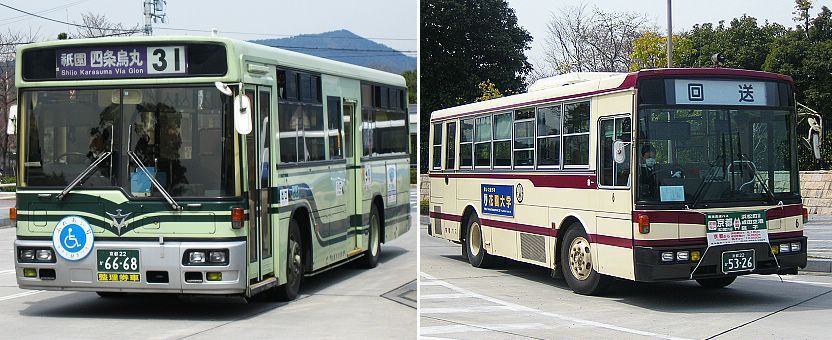
There are two subway lines in Kyoto , the Karasuma Line which runs from south to north along Karasuma-dori and stops at JR Kyoto Station, and the newer Tozai Line which runs from east to west and meets the Karasuma Line at the intersection of Karasuma-dori and Oike-dori.
Japan Railways
All JR lines, including the Tokaido Shinkansen , pass through or commence at JR Kyoto Station . JR trains can be a convenient for accessing the Arashiyama area (JR Sagano Line) and some attractions in southern Kyoto along the JR Nara Line, e.g. Fushimi Inari Shrine and Uji .
Other Railways
- Hankyu Railway connects Kyoto with Osaka . The line initially runs below Shijo Avenue from Kawaramachi westwards in direction of Osaka. It is a good option for accessing the area around Katsura Rikyu , from where a branch line also connects to Arashiyama .
- Keifuku Railway (also known as Randen) operates two tram-like train lines in northwestern Kyoto. For train lovers, a ride on these trains is a small attraction by itself. The lines can be an option for accessing Arashiyama and the area around Ryoanji and Kinkakuji .
- Keihan Railway 's main line runs next and parallel to Kamo River, but unfortunately does not connect to Kyoto Station . The line continues to Osaka and is an alternative to the JR Nara Line to access some of the attractions in southern Kyoto.
- Eizan Railway operates two train lines from where the Keihan Line ends, Demachiyanagi Station. One line leads to Kurama , while the other runs to the base of Hieizan .
- Kintetsu Railway connects Kyoto Station to Nara . Note that some trains on the Karasuma Subway Line continue to run on the Kintetsu Nara Line and the other way around.
By sightseeing bus
The Sky Hop Bus is an expensive but convenient way to visit Kyoto's most famous sightseeing spots. Double-decker buses with an open-air second floor run clockwise every hour from Kyoto Station in a large circle around the city, stopping near major tourist sites along the way, including Nijo Castle , Kinkakuji , the Imperial Palace , Heian Shrine and Kiyomizudera . A 1-day pass costs 4000 yen and a 2-day pass costs 6000 yen and can be purchased through Klook .
Kyoto is probably the Japanese city with the highest concentration of taxis . Especially in the city center, taxis are found everywhere. Taxis can not only be a more comfortable, but also an economical alternative to buses on short to medium distances for groups of three or more.
Most taxis accommodate up to four passengers (not including the driver), while larger vehicles are able to accommodate an additional fifth passenger. The rate starts around 500 yen for the first kilometer and increases by 100 yen for every additional 250-300 meters traveled.
Kyoto City's simple layout and flat terrain make it easy and convenient to explore by bicycle . Numerous bicycle rental outlets can be found around the city, especially around major stations, such as Kyoto Station or in popular biking areas like Arashiyama . Typical rental prices are around 1000-1500 yen per day for basic bicycles and around 1700-2500 yen for electric assist bicycles. Some lodgings may provide their guests with bicycles for a small fee or for free.
Kyoto is generally a bicycle-friendly city with relatively easily navigable roads and a handful of cycling routes, most notably along Kamo River. Designated bicycle parking is often freely available around popular sightseeing spots. The situation is a little bit more challenging in the city center due to congested roads, crowded sidewalks and a lack of designated parking areas. Also, distances to some of the more outlying sightseeing spots should not be underestimated. For example, it is about eight kilometers (typically a 45-75 minute ride) from Kyoto Station to Kinkakuji or about ten kilometers to Arashiyama .
Passes and Tickets
See also our separate page about the various passes available for the Kansai Region .
The prepaid IC card available in Kyoto is called Icoca . It does not give you any discounts over regular tickets, but it makes the process of taking trains and buses easier, as you do not always need to buy a ticket for each ride. Icoca cards can be purchased through ticket machines at JR stations. Local non-JR railway companies offer their own IC card called Pitapa ; however, Pitapa is a postpaid card that works more like a credit card and is targeted at residents.
Icoca and Pitapa can be used on virtually all trains and buses in and around Kyoto (and most other major cities in Japan). Additionally, eight other IC cards from other major cities of Japan can also be used on the trains and buses of Greater Osaka and Kyoto, including Suica, Pasmo, Kitaca, Toica, Manaca, Sugoca, Nimoca and Hayakaken.
The Kansai One Pass is a special version of Icoca exclusively for foreign tourists that additionally qualifies for discounts at various attractions in the Kansai Region . It is available for sale at Kansai Airport and major railway stations in the Kansai Region.
Furthermore, the following one day passes are available for Kyoto :
- Kyoto Sightseeing Card (1100 yen) Unlimited use of Kyoto's two subway lines and most buses (including Kyoto City Buses, Kyoto Buses, JR buses and Keihan buses) in central Kyoto and outskirts, including Ohara and Daigoji on one calendar day. The pass also comes with discount coupons for selected sights in Kyoto. It can be purchased from ticket machines in subway stations, at bus ticket centers and from some hotels. The pass can pay off especially if you visit outlying areas such as Ohara . The downside is that, besides the subway lines, the pass does not cover any other trains which are often a convenient means of getting around.
- Kyoto Subway One Day Card (800 yen) Unlimited use of Kyoto's two subway lines on one calendar day. The card can be purchased from ticket machines at subway stations. It generally pays off if you use subways more than three times per day, however its value is restricted by the subway's limited coverage area.
Questions? Ask in our forum .
Links and Resources
Arukumachi kyoto route planner, kansai one pass, kyoto municipal transportation bureau, keihan railway, kintetsu railway, hankyu railway, kansai airport transportation, sky hop bus, enjoy cycling in kyoto, eizan railway, keifuku railway, hotels around kyoto.
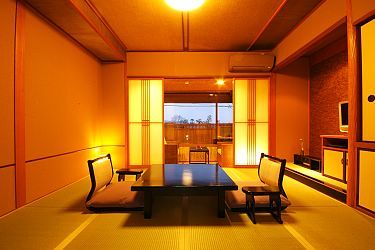
Experiences around Kyoto

Discover Snow Peak's Japan-Exclusive LOCAL WEAR and Must-Buy Souvenirs
We use cookies to improve our contents. Check the detail and update your settings here .
We use cookies to improve our services.
For more details, please click here .

- Food & Drink
- Accommodation
- Things To Do
- All the categories
Transportation
- Weather & Seasons
- Long-Term Stay
- Travel Tips
- Event Tickets
- About MATCHA
- Company Profile
- Things To Do in Kyoto
- Food & Drink in Kyoto
- MATCHA Special Features
How to Travel to Kyoto From Osaka: The Fastest and Cheapest Ways

We compare the prices and travel times for accessing Kyoto from Osaka for each means of transportation: bullet trains, regular trains, buses, taxis, and rental cars. Information on local railways and their respective day passes is also included!
Kousuke DEKI
Accessing Kyoto from Osaka Is Surprisingly Simple
Most people use Osaka as their travel hub for sightseeing in Kyoto when traveling in western Japan.
Osaka and Kyoto are very close being neighboring prefectures with simple accessibility . This article introduces a complete guide on major travel routes from Osaka to Kyoto .
The travel time from Osaka to Kyoto is 15 minutes by shinkansen (bullet train), 30 to 50 minutes by train, and around an hour and a half by bus or taxi. Let’s take a look at the respective features of each transportation method.
Table of Contents:
1. Bullet Train: The Fastest Method 2. Train (JR, Hankyu, Keihan Lines): The Most Recommended 3. Bus and Taxi 4. Cars are Convenient for Road Trips 5. Train Ticket Deals Between Osaka and Kyoto 6. Frequently Asked Questions
Bullet Train (Shinkansen): The Fastest Method
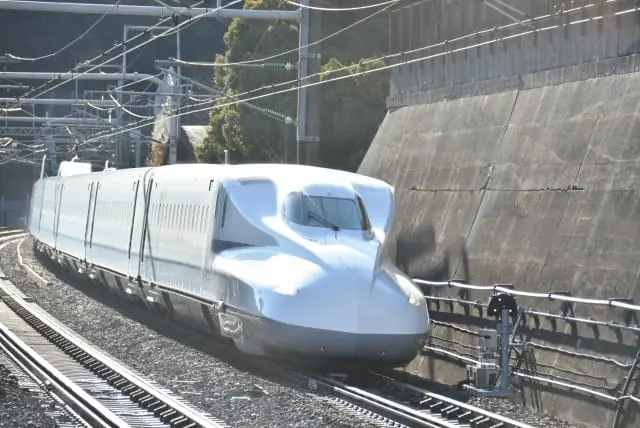
The Shinkansen (bullet train) is the fastest way to travel between Osaka and Kyoto. You can reach JR Kyoto Station from JR Shin-Osaka Station , a single stop away on the Shinkansen, in just 15 minutes.
However, the difference in travel time when compared to taking a train is about 15 to 30 minutes. If you’re not in a rush, avoiding using the Shinkansen is more cost efficient, since it is 1,420 yen more (unreserved seat) compared to the train at 1,000 yen.
We do recommend this method if you’re an overseas visitor with a Japan Rail Pass (JR Pass) since it grants unlimited rides on Shinkansen trains. Please remember that you cannot board the Nozomi trains since the JR Pass only allows ride access to the Hikari and Kodama trains on the Shinkansen line.
Train (JR, Hankyu, Keihan Lines): The Most Recommended
To travel from Osaka to Kyoto, the train is the best option after considering the balance between cost efficiency and speed.
There are three routes available: the JR, Hankyu, and Keihan Railways. The platforms and departure stations will differ for each railway, so please use the railway that best fits your travel purposes.
JR: Fast and Easiest Route to Understand - Osaka Station → Kyoto Station

Traveling on a JR Line has the benefit of shorter travel times and ease of use .
Route Take the special rapid bound for Kyoto on the JR Kyoto Line from JR Osaka Station to arrive at JR Kyoto Station in 30 minutes . It costs 570 yen .
If you plan to take the train from JR Shin-Osaka Station , it takes 25 minutes to JR Kyoto Station and costs the same 570 yen.
Benefits The travel time is shorter than the Hankyu Railway. It is easy to understand how to use this line being a direct route from Osaka Station to Kyoto Station.
Precautions Please note that Kyoto Station is quite a distance from places in the downtown area, like Kawaramachi.
Hankyu: Access Downtown Kyoto Without Transfers - Osaka-Umeda Station → Kyoto-Kawaramachi Station

If you plan to take the Hankyu Railway, you will board a train from Osaka-Umeda Station located adjacent to JR Osaka Station. You can easily access Kawaramachi, Kyoto, near central Kyoto, without any transfers.
Route Take the limited express bound for Kyoto Kawaramachi on the Hankyu-Kyoto Main Line from Hankyu Osaka-Umeda Station. You will arrive in 45 minutes . It costs 400 yen (the JR Pass cannot be used on this route).
Benefits You can access Kyoto-Kawaramachi Station near Gion and shopping areas without any transfers.
Precautions Osaka-Umeda Station is adjacent to Osaka Station. Please note that walking to the station will take about 5 to 10 minutes.
Keihan: Easy to Access Sightseeing Spots - Yodoyabashi Station → Sanjo Station

Photo by Pixta
The Keihan Railway services areas further from the city center compared to Hankyu Railway. But this is what contributes to its unique charm.
The shops inside the station and posters on the walls are visible differences between stations serviced by Keihan or Hankyu Railway. It might be fun to spot the differences between the respective railways!
Route Take the limited express bound for Demachiyanagi from Yodoyabashi Station, Osaka, to Sanjo Station, Kyoto for 50 minutes . It costs 420 yen (the JR Pass cannot be used).
Benefits Keihan is known for servicing stations near sightseeing spots. For example, Yodoyabashi Station is near the Nakanoshima Museum of Art Osaka. Sanjo Station is also near Heian Shrine and Yasaka Shrine. Additionally, it’s a convenient train line when visiting destinations like Fushimi Inari Grand Shrine, Iwashimizu Hachimangu Shrine, and a local amusement park called Hirakata Park.
Precautions Yodoyabashi Station is around 15 to 20 minutes on foot from Osaka Station.

Umeda / Shinsaibashi / Namba
Bus and Taxi

Buses depart for Kyoto Station from Hotel Keihan Universal Tower and Universal Studios Japan (USJ). There are no buses that service the route between Osaka Station and Kyoto Station, so please take note of this.
Travel time from Hotel Keihan Universal Tower to Kyoto Station ranges between one to two hours. Fares start from 700 yen. Since the travel time and pricing are subject to change, make sure to confirm these details on the Highway Bus WILLER website .
If traveling by taxi , then the travel time will be an hour and a half, priced at 15,000 yen. Taking a taxi is a good option if you are traveling with multiple people and have a lot of luggage or wish to travel directly to your destination.
Make a reservation for an Osaka or Kyoto hotel on Rakuten Travel Buy tickets at a value for the highway and night buses!
Cars are Convenient for Road Trips

You can arrive in approximately one hour by driving on the expressway from Osaka to Kyoto. Highway toll fees are roughly 3,000 yen one-way.
Honestly, a rental car isn’t an appealing option if you plan on sightseeing within central Osaka and Kyoto.
However, many spots are easier to travel with a rental car in the Kansai region. Some of these destinations include Amanohashidate , ranked among the three most scenic views in Japan and located in Kyoto, Ine , and Maizuru for their historical landscape and scenery. A rental car would also make visiting popular cafes and other places in the area easier when traveling around major sightseeing destinations.
Several car rental companies are available in Osaka and Kyoto. MATCHA has a 10% discount coupon when renting a vehicle from Nippon Rent-A-Car. Please consider using this coupon on your next rental!
Click Here for 10% Off Coupon on Nippon Rent-A-Car

Coupon Included! How to Rent a Car in Japan: A Guide for International Visitors
Train Ticket Deals Between Osaka and Kyoto
The information above should be sufficient if you only plan to travel between Osaka and Kyoto.
However, if you plan to travel around Osaka and Kyoto for sightseeing, please know there are day passes sold for a great deal. Be sure to check them out!
For example, Hankyu Railway sells several day passes for a bargain. This includes the Hankyu Hanshin 1-Day Pass (Japanese), which allows unlimited rides for one day on all lines serviced by the Hankyu, Hanshin, and Kobe Rapid Transit Railways.
Keihan Railway also offers budget passes. The Osaka-Kyoto 1-Day Sightseeing Pass can be used to receive specific benefits at shrines, temples, and facilities along the Keihan Railway.
Day Pass Deals for Overseas Visitors
Transportation companies also offer unlimited ride pass deals marketed to overseas visitors.
For example, the JR Kansai WIDE Area Pass gives you unlimited rides on regular trains, limited express, and Shinkansen (bullet trains) serviced by JR. This pass can, of course, be used in Osaka and Kyoto. It can even be used further out in Kobe and Okayama.
The Kansai Thru Pass is an unlimited ride pass for lines on metro services in Osaka, Kyoto, and Kobe, but excludes the JR lines. It also includes lines serviced by Keihan Railway, Hankyu Railway, Kintetsu Railway, and Nankai Electric Railway.
There’s also a day pass called the Hankyu Tourist Pass . This pass can be used exclusively on the Hankyu Railway at a discounted price.
Are there sightseeing trains to enjoy in the Osaka and Kyoto areas?
Yes. Options include Aoniyoshi, a sightseeing limited express by Kintetsu that travels from Osaka to Kyoto via Nara. There's also the Kyo-Train Garaku serviced by Hankyu that connects Osaka-Umeda Station with Kyoto Kawaramachi.
Can I cycle around Osaka or Kyoto?
Yes. There are various cycling courses in Osaka and Kyoto. Please read Osaka Prefecture’s official website for details on Osaka and read Kyoto City Tourism Association’s official website for details on Kyoto.
How much does it cost to go from Osaka to Kyoto?
Traveling from Osaka to Kyoto offers several transportation options with varying costs. Taking the JR trains, including regular trains and Shinkansen bullet trains, typically ranges from 560 to 3,000 yen for a one-way ticket. The Hankyu Railway and Keihan Railway provide services between the two cities for approximately 400 to 610 yen and 400 to 580 yen, respectively. Opting for a highway bus can cost around 1,000 to 2,000 yen for a one-way trip. Alternatively, taking a taxi or ride-hailing service like Uber can be significantly more expensive, with costs ranging from 15,000 to 25,000 yen or more. Prices can fluctuate based on factors like service type, time of day, and ongoing promotions, so it's advisable to check with the transportation providers directly for the latest pricing details before traveling between Osaka and Kyoto.
Which train is best from Osaka to Kyoto?
When choosing the best train from Osaka to Kyoto, various options cater to different preferences. The JR Special Rapid Service stands out for its convenience, offering frequent departures and reasonable fares, making it a preferred choice for many travelers seeking a balance between speed and cost. On the other hand, the Shinkansen (Bullet Train) provides unparalleled speed, completing the journey in a fraction of the time, though at a higher price point. The Hankyu Railway and Keihan Railway offer scenic routes with comfortable limited express trains, appealing to those who prioritize a more leisurely journey. Ultimately, the ideal train service for traveling between Osaka and Kyoto depends on individual priorities, whether it be speed, affordability, or experience, allowing travelers to select the option that aligns best with their preferences and travel needs.
Can you do a day trip from Osaka to Kyoto?
A day trip from Osaka to Kyoto is a feasible and popular option due to the short distance and efficient transportation connections between the two cities. Travelers can utilize various train services like the JR Special Rapid Service, Shinkansen, Hankyu Railway, or Keihan Railway for the journey. Planning a well-structured itinerary is key to maximizing the experience, focusing on visiting key attractions such as Fushimi Inari Taisha Shrine, Kinkaku-ji, Arashiyama Bamboo Grove, Gion District, and Nishiki Market. Starting early, staying flexible, and considering a guided tour can enhance the day trip experience, allowing visitors to immerse themselves in Kyoto's rich culture and heritage before returning to Osaka.
How much is a bullet train from Kyoto to Osaka?
The cost of taking a bullet train (Shinkansen) from Kyoto to Osaka can vary depending on factors like the type of service, seating class, and the use of a Japan Rail Pass. For travelers without a Japan Rail Pass, a one-way ticket on the Nozomi or Mizuho Shinkansen between Kyoto and Shin-Osaka Station typically ranges from 1,420 to 3,000 yen. With a Japan Rail Pass, the use of the Hikari or Kodama services offers a slightly slower but more economical option, costing around 1,420 to 2,800 yen for a one-way journey. Seating class can also affect the cost, with Green Class being pricier than Ordinary Class. Checking with Japan Railways for the most current fares and schedules before your trip, and considering booking in advance for potential savings, is advisable when planning your bullet train journey between Kyoto and Osaka.
Travel the Way That Best Fits You
The most convenient way to access Kyoto Station from Osaka Station is by train.
However, every method of transportation will have its respective pros and cons. Decide which transportation to take according to your schedule and travel route!

Osaka station

Shin-Osaka Station

Main image by Pixta *This article is an updated 2023 version of an article published on March 18, 2018.
MATCHA Editer.
Related topics
Top articles.

The World's First Tatami-Floored Starbucks! Kyoto Ninenzaka Yasaka Chaya
20 Little-Known Kyoto Spots: Hidden Gems Worth Visiting

Gion at Night: A Dreamlike Townscape in Kyoto
Related article.

Shinkansen: How to Buy Bullet Train Tickets 2024

Japan Rail Pass (JR Pass): How to Buy and Use, Price, and Benefits

How to Get to Nara From Osaka and Kyoto 2024: Travel Times and Price

How to Reach Kumamoto From Tokyo and Other Regions in Japan

Kyoto Travel Tips: Transportation and Major Sightseeing Areas

How To Get To All 5 Umeda Stations From JR Osaka Station!

How To Easily Reach Osaka, Kobe And Kyoto From Kansai Airport
Start planning your trip
Special Features

Popular Searches
Latest news.

Expo Summer Festival 2024: Osaka's Lively Summer Celebration

Mt. Mitake Rengeshoma Festival 2024: See Tokyo's Rare Wildflowers

This August! Tatsuya Tanaka's MINIATURE LIFE Exhibition 2024 in Tokyo

Nara Tokae Lantern Festival 2024: See 20,000 Enchanting Candles!

Summer in Enoshima 2024: Mystical Shrine Light-ups and 1,000 Lanterns

Riding Taxis in Japan: The 7 Best Apps to Grab a Cab

Self-Introduction In Japanese: 16 Phrases You Should Know

Beyond Arigato! How to Say Thank You in Japanese: 12 Phrases for Every Situation

Food Expenses for Travel in Japan: 1,000 Yen Meals and Budget Tips
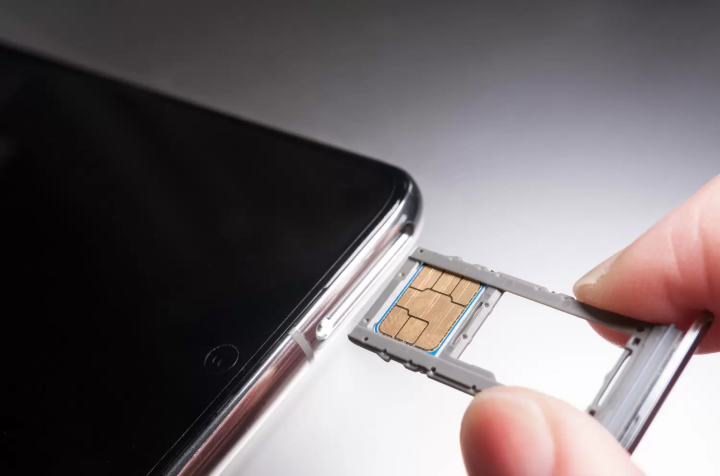
SIM Cards in Japan: Top 7 Services for Travelers in 2024
New articles.

Capture My Japan: The Best Travel Photography Service to Immortalize Your Trip

Must Buy Unique Lucky Charms and Fortune Items in Hiroshima!

Nakano: 15 Things to Do in Tokyo's Retro Pop Culture Hub

8 must-see spots in Tokyo for viewing autumn leaves during your trip to Japan in the fall

Must-Buy 11 Nagoya Souvenirs: From Sweets to Local Crafts
How to get from Kyoto to Osaka
- Published on : 02/05/2024
- by : Joshua
- Add to favorites
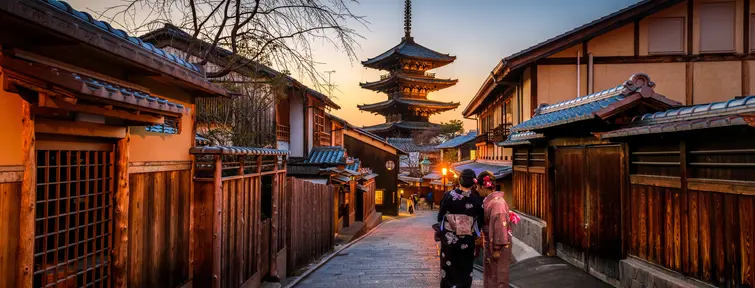
@sorasak-_UIN, Unsplash
No two cities are said to represent the Kansai Region more than Kyoto and Osaka, and getting from one to the other is made easy with the popular limited express trains that service the area!
Getting from Kyoto to Osaka with limited express trains
Getting from kyoto to osaka by train.
For many, the Kansai Region of Japan is defined by two prominent cities: Kyoto and Osaka. Despite being geographically nearby, the environments of the two cities differ immensely while maintaining the core Kansai DNA. Getting from Kyoto to Osaka is made easy using either the locally-beloved Thunderbird Limited Express Train or the Haruka Limited Express Train that is often used for getting to and from Kansai International Airport.
Kyoto is often seen as the city that embodies traditional Japan. Home to 17 UNESCO World Heritage Sites, and the former capital of Japan up until the Meiji Restoration in 1868. Every street in Kyoto is teeming with stories and history, and picturesque scenes that are often representative of Japan exist just a short walk from modern urbanscapes.
Osaka is the third most populous city in Japan, with a lively environment and rich culture to reflect that. Wander around the old-school streets of Shinsekai and Dotonbori and eat some delicious street food like takoyaki. Then, take a look at the historical sites nestled within the urban landscape, such as the ancient Mozu Tombs, and prepare for the 2025 Worlds Fair that wil be held in Osaka by visiting the Tower of the Sun, designed by Taro Okamoto for the last Worlds Fair to be held in Osaka back in 1985!
Japan’s famous train system is the key to seeing both destinations and getting the full experience of Kansai, which ought not to be missed for your next trip! The Shinkansen bullet train using the Tokaido Sanyo Line makes the journey quick and simple, getting from Kyoto to Osaka in just a bit under 15 minutes. Both the Thunderbird Limited Express Train and the Haruka will depart from Kyoto Station. The Haruka Limited Express Train will go all the way out to Kansai International Airport, with a stop at Osaka Station in between. The two limited express trains will take a bit more time compared to the Shinkansen bullet train. Additionally, the local Keihan Line can be ridden all the way from Kyoto to Osaka. This option takes the most time and doesn’t have the option to reserve seats, but can still be a viable and convenient option if needed. All these trains are rideable with the Japan Rail Pass, however, riding the Nozomi Shinkansen bullet train, will entail an extra cost with the Japan Rail Pass.
Trains available on this itinerary:
NOTE: Osaka Station is NOT the final stop for Tokaido-Sanyo Shinkansen trains or Limited Express Trains. These trains will often go past Osaka Station, so be wary of the stops on your journey and preparing ahead of time to disembark, especially as the journey between Kyoto and Osaka is shorter than other itineraries.
Reserving seats on the train in Japan
On Shinkansen and Limited Expres trains, individual ticket holders and holders of Japan Rail Passes can reserve seats in advance of boarding. Reservations are not always required for these trains because many of them have non-reserved cars with seats that are available on a first-come, first-served basis. These are often car numbers 1-4.
There are some trains when all cars require a reservation, even though a lot of people utilize the train services during these hours. However, we also strongly advise all visitors to try and book reservations for tickets during Japan's busiest travel seasons, which include the spring and the New Year's holiday. When purchasing a single ticket, a reserved seat costs more; however, Japan Rail Pass users will not be charged an additional cost.
Oversized Baggage on the Limited Express trains
While there are limitations to baggage size on the Tokaido-Sanyo Shinkansen, other Shinkansen lines and Limited Express trains DO NOT have such regulations. This includes the Thunderbird and Haruka Limited Express Trains. However, to get to Osaka from Kyoto in Kansai, the Tokaido-Sanyo Shinkansen is a popular option, so if you plan to utilize this Shinkansen train line, be aware that any luggage that is 160cm in total dimensions (LxWxH) up to 250cm is considered “oversized” and will need a special seat reservation that simultaneously allows for use of the oversized luggage area for storage.
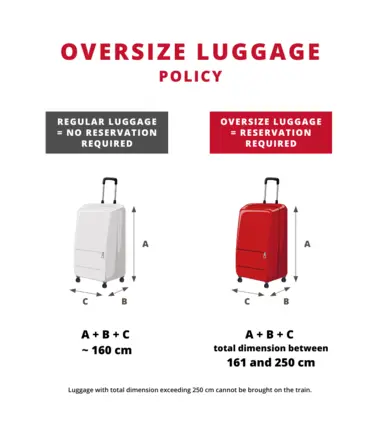
Dimensions for luggage on the Shinkansen bullet train
Exploring Kyoto
Kyoto, the historic capital of Japan, is a culturally vibrant city brimming with history and home to 17 distinct UNESCO Heritage Sites. Kyoto is situated in the Kansai region, a culturally varied area of Japan renowned for its colorful locations. For visitors taking the Japan Golden Route, Kyoto is frequently the next stop after Tokyo.
The temple itself and the ascent to Kyomizudera are two of Kyoto's most famous sights, and both are worthwhile excursions. Explore a little off the usual route; the hilly lanes leading up to the temple are lined with quaint stores and eateries! Then, Ginkakuji and Kinkakuji, the "gold and silver temples," serve as potent representations of Kyoto's lengthy past.
Kyoto is a metropolitan city for sure, but it's not like other major cities in Japan because it has mountains on three sides and a lot of traditional architecture instead of tall skyscrapers. Benefit from Kyoto's distinctive topography by spending some time on a leisurely trek where you can take in the surrounding scenery. One of the simpler walks in the area is from Shogunzuka to Seiryuden, which takes around two hours to reach Chion-in Temple. Enjoy an unrestricted perspective of the city from a high vantage point and discover Kyoto in a way you never would have imagined.
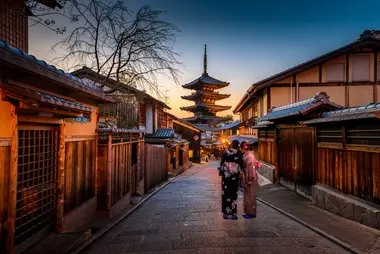
Travelers arrive at Kyoto Station and are immediately in the heart of the historic capital. Not many towns in the world can match Kyoto's distinction of being the first city to commemorate its 1200th anniversary—a feat that was accomplished in 1997 when the station underwent its current design by renowned architect Hiroshi Hara. There are a few convenience stores, cafes, and restaurants inside the station, however, it is not as big as other important stations like Tokyo Station, Shinjuku Station, or even Hakata Station. Nonetheless, the lit staircase—whose display varies with the season—is one of Kyoto Station's most identifiable features. Conveniently located near the station, the well-liked Ume-yu is a sento bathouse with a charming atmosphere that's perfect for lounging and passing the time in a relaxed, residential area, complete with unique and eccentric merchandise to bring home.
Exploring Osaka
Osaka, the most populous city in Kansai and the third most populous city in all of Japan, is well-known for its energetic atmosphere, delicious street cuisine, and eccentric set of locals. Tokyo is generally seen as Osaka's partner city—or adversary, depending on who you ask. It is also often cited as a partner city to Kyoto, the other city said to represent Kansai that is also very nearby.
The vibrant central Osaka areas of Umeda, Namba, and Dotonbori are a favorite destination for tourists due to their distinctive Japanese urban environment and plenty of diverse businesses. Dotonbori's running Glico Man, commonly regarded as the Osaka symbol, is a popular photo location overlooking the area's renowned bridge. You won't have to go far to find a more subdued mood if you want to escape the hustle and bustle of the city center because Honmachi is a more tranquil district that is still close to it.
Although Osaka is well recognized for its energetic atmosphere, art and culture lovers should also make time to visit this city. Because the city hosted the World's Expo in 1970, artist Taro Okamoto built the famous "Tower of the Sun" (太陽の塔).
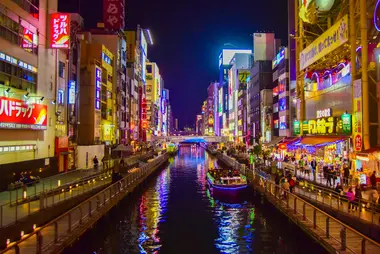
Osaka - Dotonbori - Canal
©Juliana Barquero - unsplash
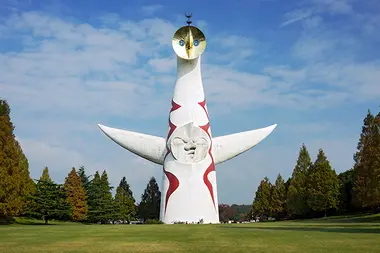
Tower of the Sun by Taro Okamamoto in Osaka, Japan
The tower is still on display at Expo Park for visitors to see. A must-see location for anybody interested in even more ancient history is the Mozu Tombs, which house a number of fifth-century kofun (burial tombs). A unique historic landmark among the contemporary structures in the Osaka metropolitan area are these old burial grounds. The burial grounds vary in size and shape when viewed from above; the larger ones resemble key holes.
The definitive Kansai experience
Using a combination of both the iconic Thunderbird Limited Express Train and the Haruka Limited Express Train, the journey between two of Japan’s most culture-rich cities, Kyoto and Osaka, is made easy! Witness history and modern-day beauty with this itinerary, taking not even two hours of transit using some of the world’s most cutting edge means of transportation.
Latest Articles
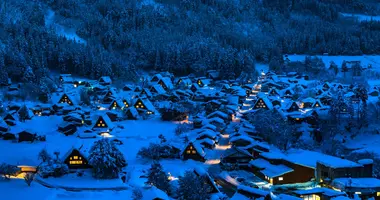
How to get from Kanazawa to Takayama
Go from Kanazawa to Takayama with the Hokuriku Shinkansen and the Hida Express Train!
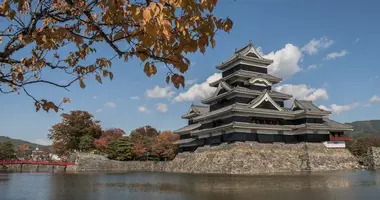
How to get from Tokyo to Matsumoto
Use the Azusa Limited Express Train to get from the metropolitan capital of Japan, Tokyo, to the historically rich but modest town of Matsumoto in Nagano Prefecture!
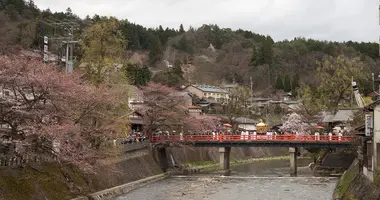
How to get from Nagoya to Takayama
The terminal station of the Hida Limited Express, Nagoya in Aichi Prefecture, goes out to the other side of Honshu Island to the Japan Sea Coast, and halfway through, it stops at Takayama, a nature
All the themes of the city

Unique Trains in Japan

Japanese Stations
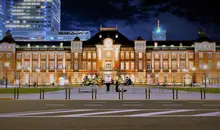
Getting Around Tokyo
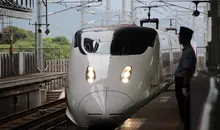
Shinkansen Travel Tips
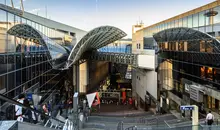
Getting Around Kyoto
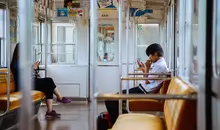
Trains in Japan
Please select your country on the list below:
- Switzerland
- United Kingdom
- Other countries
- Itineraries
- Tours and Activities
- Travel Guides
- Best of Japan
JRailPass.com » Japan Travel Blog » How to go from Osaka to Kyoto

How to go from Osaka to Kyoto
July 11, 2024

Traveling between Osaka and Kyoto is easier than ever. The two cities are well-connected and there are numerous ways of making the journey.
The fastest way to travel from Osaka to Kyoto is by rail. Using your JR pass you can catch a Shinkansen bullet train which only takes around 15 minutes to travel a distance of 56.4km . There are also bus routes but they can’t match the trains for time or comfort.
Kyoto is one of Japan’s best-preserved cities and it’s worth taking the time to visit. There’s an astonishing number of shrines, temples, palaces, and gardens and it’s one of the best places to witness authentic Japanese traditions such as geisha dancing and Zen meditation.
Osaka to Kyoto by train
Osaka and Kyoto are very well-connected by train as there are 4 different lines you can take. The best rail line to use depends on where you’re traveling from in Osaka and which part of Kyoto you wish to visit.
The best connected stations are Shin-Osaka, Osaka Station and Kyoto Station. But don’t worry: whichever way you go the journey is quick (between 15 and 5 minutes) and the fastest routes are covered by the JR Pass .
JR Tokaido Shinkansen
Covered by JR Pass
The Shinkansen service which runs from Shin-Osaka Station to Kyoto Station is the fastest way and it’s covered by the JR Pass. The bullet train time is only 15 minutes . If you don’t have a JR Pass, the Shinkansen price for this journey is 1,420 yen. The available train services between Shin-Osaka and Kyoto Station by the Tokaido Shinkansen are Nozomi, Hikari and Kodama .
From October 2023, JR Pass holders can ride on a Nozomi service if they pay a supplemental fee.
There are Shinkansen departing from Shin-Osaka to Kyoto Station from 6:00 a.m to 08:01 p.m., one every 10 minutes approx. If you only count those covered by JR Pass, there is one every 25 minutes approx.

JR Kyoto line
Covered by JR Pass , Hokuriku Arch Pass , Kansai Area Pass , Kansai Wide Area Pass , Kansai-Hiroshima Rail Pass , Kansai-Hokuriku Area Pass , Sanyo-San’in Area Pass , Sanyo-San’in Northern Kyushu Pass
Although there are 16 stations along this line, only local trains stop at all of them. The Special Rapid is the fastest and most convenient service in this line since it only stops at Osaka, Shin-Osaka, Takatsuki and Kyoto.
The Special Rapid trains run between Osaka Station (departing from platforms 8, 9 and 10) and Kyoto Station and they take between 24 and 29 minutes (depending on the train schedule ). Though they are slower than the bullet trains it’s the quickest way if you’re close to Osaka Station. Tickets are only 560 yen (or free with a JR Pass ).

As well as Special Rapid Trains, you can take the Limited Express Thunderbird fully covered by your JR Pass (without it, the price of the ride is between 1210 and 1930 yens). This train runs from Osaka Station to Kyoto Station passing only by Shin-Osaka, the journey takes 30 minutes .
Book your Japan Rail Pass now
The Hankyu Kyoto Line
Not covered by JR Pass
Hankyu Railway is a private company which is not covered by the JR Pass. It goes from Hankyu Umeda Station to central Kyoto in 44 minutes . Though it’s not the quickest, it only costs 400 yen so it’s a good option if you haven’t got a JR Pass. It also provides easy access to attractions in western Kyoto.
The Keihan Main Line
Not covered by JR Passes
A limited express train takes you from Yodoyabashi Station to Sanjo Station in 55 minutes and costs 410 yen. It’s a handy option for sightseeing as stops close to many of Kyoto’s most iconic sights . It’s run by a private company not covered by the JR Pass.
Osaka to Kyoto by bus
As an alternative, there is a bus that covers the trip between Universal City Station, in Osaka, to Kyoto Station.
There are 3 bus stops in Osaka from which to go to Kyoto by Bus: Hotel Keihan Universal Tower, Universal Studios Japan and Namba (OCAT). There are 5 daily buses that cover this route.
Kansai International Airport to Kyoto
The journey from Kansai International Airport (KIX) to Kyoto takes longer than from central Osaka. The fastest option is the Haruka Express (limited express) which takes 70 minutes to get to Kyoto Station. It’s covered by the JR Pass but costs 1,880 yen if you don’t have one.

There’s also a slower, cheaper option (covered by the JR Pass). You can take JR Kansai Airport Rapid Service train (for Kyobashi) to JR Osaka Station, then transfer to JR Special Rapid Service train (for Nagahama) to JR Kyoto Station.
Kansai Airport to Kyoto by Bus
There are ‘ limousine buses ’ which run twice an hour from the arrival lobby. The journey takes around 2 hours . You can buy tickets at the airport or online.
Related posts
Related tours & activities.
Make planning your Japan trip that little bit easier
The Best Way to Get From Osaka To Kyoto – For You
- Latest Posts
- Step-By-Step Guide to Booking Your Tokyo Disney Visit - 18 August 2024
- Is the Aoniyoshi Train Worth It? - 17 August 2024
- Where to Stay in Osaka on Your First Trip - 9 August 2024
If you’re planning a trip to Japan, and are planning to either stay in both Osaka and Kyoto or, take a day trip between the two, you need to know how to get to Kyoto from Osaka – and we’re going to explain just that – and highlight the best choice for you to take for your budget, or where you want to end up in Kyoto.

Article by Helen Foster. Disclosure: Some links in this post are affiliate links. See our Affiliate Disclosure.
Osaka to Kyoto Options – At a Glance
These are the best ways to get to different parts of Kyoto from Osaka or, the best choices for different types of travelers. We’ll explain each of them in more detail in the post that follows.
If you have a JR Pass: The Shinkansen or the JR Line Tokaido Sanyo Main Line
If you have a Kansai Pass: The Shinkansen, the JR Line Tokaido Sanyo Main Line, or the Haraku line – exactly which depends on your pass.
The cheapest route: The Hankyu or Keihan Lines
To visit Arashiyama: The Hankyu Line, or, at weekends, the Kyo Train Garaku
To visit Gion/Pontocho: The Hankyu Line, the Kyo Train Garaku, or the Keihan Line.
To get to Kyoto Station: The Shinkansen, JR Tokaido Sanyo Main Line, or Haraku Line
From the Airport: The Haraku Line
From Namba, Shinsekai or Tennoji: The Haraku Line
The Pretty Option: The Kyo Train Garaku or the Hello Kitty Haraku
Don’t Like Planning? Take a tour – we suggest a couple below
If you need more advice, then, keep reading. You can also use the Table of Contents below to jump to the method that sounds best if you’re short on time.
- Why Picking the Right Route Matters
Kyoto and Osaka are 33 miles (55 kilometers) apart. However, despite their proximity, there are six different routes to get from Osaka to Kyoto by train.
It can take as little as 15 minutes or around an hour to travel from Osaka to Kyoto depending on the train you choose – pick the wrong one and you’ll be wasting valuable time on your trip.

Picking the wrong train can also cost you more – as you can pay as little as 410 yen or as much as 3020 to get between Osaka and Kyoto depending on which train line and route you choose.
The journey can also be free if you have a JR Pass or one of the Kansai Area Passes that include travel between both cities.
1. The Shinkansen
2. using the hankyu line, 3. the kyo train garaku, 4. jr line tokaido sanyo main line, 5. haruka line, 6. the keihan line, day tours from osaka to kyoto, the six trains between osaka and kyoto.
The train is the best choice for most people traveling between Osaka and Kyoto but there are a lot of lines linking the two cities. Here’s how to pick the best one for you.
Great For: Those with a JR Pass . Getting to the Kyoto Station area .
The Shinkansen bullet trains are the fastest and most convenient way to get around long distances in Japan. This mode of transport can be expensive, but if you’re traveling with a JR Pass the journey is included in your pass for free.

The bullet train runs from Shin-Osaka Station to Kyoto Station and the journey only takes 15 minutes. Nozomi trains can depart Shin-Osaka Station as frequently as every 10 minutes (slightly less often for Hikari and Kodoma) and the first train is just after 6 am.
If you don’t have a pass but just want to ride the bullet train because, erm, it’s fun! the Shinkansen fare between Osaka and Kyoto is ¥3070 (US$21.75, £16.93, AU$32.71) if you want to use a reserved seat.
Or use an unreserved seat and you’ll pay just ¥1,450 – with such a short journey time, it wouldn’t be the end of the world if you have to stand.
You can just turn up on the day and buy a ticket. Or, if that makes you nervous and you want to firm up your itinerary in advance, you can book your Shinkansen ticket in advance on Klook.
Don’t Waste Money on the Nozomi
Osaka and Kyoto are connected by three different types of Shinkansen – the Nozomi, Kodama, and Hikari.
The JR Pass doesn’t permit travel on Nozomi train services without an additional fee, but it’s not worth paying for on this journey as the main difference between the Nozomi and the other trains is how many stops they make – and there aren’t any between Osaka and Kyoto.
Great For: Those staying near Osaka Umeda. Those visiting Gion, Pontocho, Nishiki Market, or, Arashiyama. Long Day Trips
If you don’t have a JR Pass, the Hankyu Line is one of your best options. It gets you to the heart of Kyoto.
The train goes from Osaka-Umeda Station to Kyoto-Karawamachi Station located right in central Kyoto by Gion, Pontocho, and Nishiki Market in approximately 48 minutes. You can also make an easy change to get to Arashiyama.
And it only costs ¥410 (US$2.90, £2.26, AU$4.37).

The first Hankyu Railway train to Kyoto departs Osaka around 5 am. They then run every 15 minutes until the last train at 11.45 pm which makes it perfect for long day trips.
This is the option I chose when I had to get from USJ in Osaka to Kyoto on my last trip and it was so convenient to end up right by Pontocho just as the lights were coming on.
If you do take this route on a Kyoto day trip, and leave Osaka early I get off at Katsura and change to the branch that takes you to Arashiyama. This will then let you see the famous bamboo forest before the crowds arrive. Then you can take the local bus, train, or other transport around Kyoto, or, jump back on the Hankyu line to Kyoto Kawaramachi in the center.
Save Some Extra Money
If you are doing a day trip on the Hankyu Line, check out the Hankyu Access Pass. This allows you to use the line all day for a set price. The one-day pass costs ¥700 (US$4.95, AU$7.85, £3.89).
This pass will save you money even if you’re just taking the return journey from Osaka to Kyoto. And, as we said, you can also use the pass to visit Arashiyama where you’ll find the famous bamboo forest, the Sagano Romantic train, and lots more sights.
Great for: Weekend travelers, those visiting Gion, Pontocho, and Arashiyama, getting pics for Instagram!
If you want to travel between Osaka and Kyoto at the weekend, there’s a special train on the Hankyu line that you can take between Osaka Umeda and Kyoto Karawaramachi. Aside from being one of the easiest ways to get between the two cities, this is also one of the prettiest.

The Kyo Train Garaku is a sightseeing train with six carriages, each with a different theme. Run by the Hankyu train company, it can get you to Kyoto in less than 50 minutes.
It’s themed around Kyoto’s seasons – and it even has a zen garden in some carriages! You can wander around the train before it leaves Osaka. There are no reserved seats so choose the carriage you think is prettiest.
This train operates on Saturdays and Sundays and leaves Osaka at 9.32, 11.32, 13.32, and 15.32.
Surprisingly, the Kyo Train Garaku costs the same as the normal Hankyu Railway trains. You’ll pay just ¥410 each way.
To learn more about this train, and see more pictures that show how pretty it is, check out our Kyo Train Garaku guide . I timed my trip down to USJ in Osaka specially so I could get on this in the afternoon.
Also great for JR Pass Holders, and Kansai Area Pass Holders. Those staying near Osaka Station. Getting to the Kyoto Station area.
This train line provides two trains between Osaka Station and Kyoto Station – the Main Line Local which takes 48 minutes, and the New Rapid which takes just 30. It offers the best of both worlds as it’s both fast and affordable.

Whichever service you choose, the entire journey from Osaka Station (not Shin-Osaka, make sure you head to the right one) only costs ¥580 (US$4.11, £3.00, $AU6.18) each way.
This route is included in the JR Pass, and all of the Kansai Area Passes (including the cheapest one, the Kansai Area Pass).
The first train departs Osaka at 5.00 am. After that, there are four or five trains every hour until midnight. Trains usually depart every 15 minutes.
Great for: Those flying into Osaka and going to Kyoto. Those staying in Namba, Tennoji, and Shinsekai. JR Pass Holders. Getting to Kyoto Station. Hello Kitty fans!
If you’re landing at Osaka’s Kansai Airport and heading straight to Kyoto, the Haruka Line features an express train that runs between Kansai International Airport in Osaka and Kyoto Station.
Also referred to as the Kansai Airport Limited Express, this is the fastest train service connecting the airport with downtown Osaka and Kyoto.
If you are flying into Kansai and staying in Osaka find our Kansai transport guide here. It explains your best options for getting to your hotel
This train can also be an easier option for travelers jumping on the train in the city because it also uses Tennoji Station, which can be less intimidating to navigate than Osaka Station. Tennoji is also a short ride from Namba on the Osaka loop line.

A one-way trip from the airport to Kyoto takes approximately 1hr 20 minutes and costs ¥3640 with a reserved seat. If you have a JR Pass, and some other regional passes, though this train is included.
If you’re jumping on at Tennoji, the journey takes 44 minutes and costs just ¥2680 with a reserved seat (and a bit less in unreserved)
Trains depart every 30 minutes, with departures beginning at 6:30 am and continuing until 10:16 pm.
What Was That About Hello Kitty?
The Haruku line trains between Osaka and Kyoto are Hello Kitty-themed.
Like the Hello Kitty Shinkansen that you might have read about, this is covered, inside and out of pictures of your favorite cartoon cat-human.
There are four different designs for the trains on the line, so, you could even end up riding two different ones during a return trip.
If you can’t ride the Hello Kitty Shinkansen for time or cost reasons, this could be a great alternative for any Hello Kitty fans.
Good For: Those staying in Shinsaibashi. Starting your day in Gion or Pontocho. Higashiyama, Kiyomizu-dera, and the Philosopher’s Path also have easy connections from here.
The Keihan Line is a limited express train that takes passengers from Yodoyabashi Station in Osaka to Sanjo Station in Kyoto . This is one of the best routes you can take if you want to be in the middle of Kyoto’s attractions as soon as you get off the train.
The station is an easy walk to Gion and Pontocho – and it’s also connected to subway lines that will take you toward other big sites like Kiyomizudera, Higashiyama, and the Philosopher’s Path.

The Keihan Line is operated by Keihan Electric Railway. This is a private company so you can’t use your JR Pass. Luckily, tickets from Osaka to Kyoto only cost ¥410 (£2.26).
The entire journey takes 55 minutes and trains depart several times an hour. The first train departs at 5:34 am and the last leaves at 12:03 am.
So that’s the six different trains between Osaka and Kyoto, but, if you don’t want to catch the train there are two more options to consider.
Other Options to Get From Osaka to Kyoto
If you’d prefer to see Kyoto in a day, you could always head to the city from Osaka on a day tour. There is a huge range of different tours that leave Osaka for the most popular tourist attractions in Kyoto.
Most tours leave Osaka between 8:00 am and 9:00 am before heading straight to Kyoto. You’ll then spend most of the day exploring the main sights in and around the city.
Popular tourist spots most tours visit include Fushimi Inari-Taisha, Kinkaku-ji (the Golden Pavillion), and Arashiyama, some also stop at Nara which might be good if you really don’t have much time in this area.

Aside from allowing you to explore Kyoto’s main sights, a tour makes everything much easier. You’ll be picked up at your hotel, taken around the city, and dropped back off in the afternoon.
Tours of Kyoto usually cost somewhere between US$38 (£30 or AU$54) and US$65 (£50 or AU$90) per person.
The Best One-Day Tours to Kyoto from Osaka
You’ll find a huge selection of tours on Klook, but the Kyoto Temples and Shrines Day Tour. covers the four biggest sites in one day for a pretty reasonable price.
This visits Fushimi Inari, with its scarlet torii gates, Kiyomizu-dera, and the golden pavilion of Kinkaku-ji, before ending up at Arashiyama, home to the bamboo forest. Check times and prices here.
If you did want to also visit Nara, the Kyoto and Nara Day Tour takes in Fushimi Inari, Kinkaku-ji, and Arashiyama, but, also stops off at Todai-ji Temple in Nara, and gives you a chance to feed the famous nodding deer as well. Check times and prices here.

Traveling by taxi to Kyoto will cost around ¥23,000 (£126). It definitely wouldn’t be our first choice for a day trip but it might be a good option for anyone traveling with smaller children or lots of luggage from one hotel to the next. Personally, I’d strongly suggest using luggage transfer to ship your bags and jumping on the train instead.
If you do want to use this option, though, the journey from Osaka to Kyoto by car usually takes 40 to 50 minutes. Ask your hotel if they can organize a transfer for you.
So there you have it our guide to the best options for getting to Kyoto from Osaka. If you do have any questions though, please ask them in our Facebook group .
Who Writes This Blog?
My name is Helen Foster, and I’m a journalist and author. My travel articles have appeared in publications including The Australian, RAC Horizons, Jetstar Magazine, Sainsbury’s Magazine, and more.
I’ve traveled to Japan five times before- solo and with my partner – and I’ve just returned from trip six in June 2023. So, everything here is pretty up to date.

Sharing is caring!
KYOTO TO OSAKA TRAIN
Kyoto to osaka bullet train facts, kyoto to osaka shinkansen.
If you are to travel from Kyoto to Osaka, the Nozomi bullet train is your perfect option. Fast travel time and amazing onboard amenities are to provide you with an outstanding travel experience.
All Kyoto to Osaka Shinkansen bullet trains are designed to offer the passengers everything they might need during the journey, including several travel classes and an extensive timetable with up to 34 daily departures. Thanks to a broad schedule you can easily adjust your plans and relax in your cozy seat, enjoying Japan's wonderful countryside from your window worry-free.
It is always better to book your tickets in advance. This helps to avoid unexpected troubles and not to worry about your trip.

Book Train Tickets from Kyoto to Osaka
What to know about kyoto - osaka shinkansen.
Adventures in Destinations Unknown
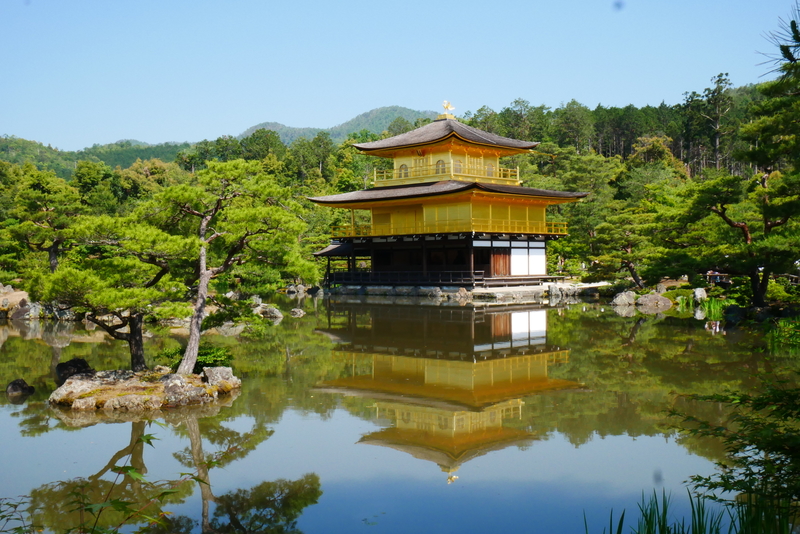
Three Day Kyoto and Osaka Itinerary
Last modified on March 3rd, 2023 at 17:46
Japan’s Kansai Region represents the country in a nutshell.
Home to atmospheric temples and colorful flashing billboards, the beautiful region on Honshu Island contains both the modern comforts and culinary delights of urban Japan, as well as the nostalgic charm of the country’s hinterland.
Kansai’s two largest cities—Osaka and Kyoto—offer the perfect introduction to Japan. Together, the cities reveal a country of quirks and contrasts, while showcasing the rich history and modern impulses that contribute to Japan’s layered and widespread appeal.
Though I only had a short weekend to spend in Japan, my three day Kyoto and Osaka itinerary revealed some of the country’s most spectacular highlights and caused me to fall in love, once again, with the Land of the Rising Sun.
Table of Contents
Our Three Day Japan Itinerary
Dan and I spent three days in Japan, excluding travel time. Due to the brevity of our visit, we chose to skip Tokyo and focused our itinerary on Kyoto and Osaka instead.
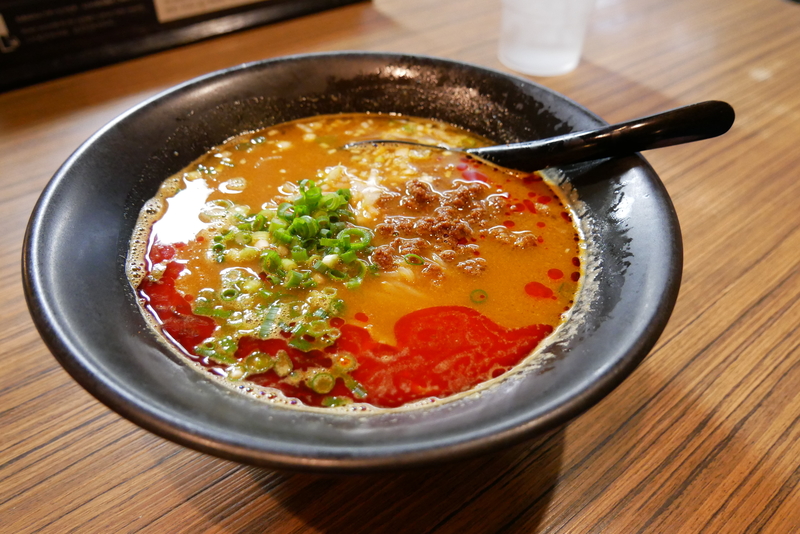
I’d visited Kyoto once before, during a high school exchange in 2007. Since my exchange, I’d hoped to return to the city to revisit its temple-laden streets and peel back its history.
Yet travel plans always seemed to bring me elsewhere. It wasn’t until twelve years later, over a long holiday weekend in May, that I finally took the opportunity to return to Kyoto with Dan.
Dan and I split our three day Japan itinerary between Kyoto and Osaka—spending two days temple-hopping in the former, and a day indulging in the culinary delicacies of the latter.
While in Kyoto, we stayed at the Nagomi Ryokan-Yuu in order to experience a traditional Japanese-style guesthouse. The ryokan was centrally located, clean, affordable and within spitting distance of the delectable Ginjo Ramen Kubota.
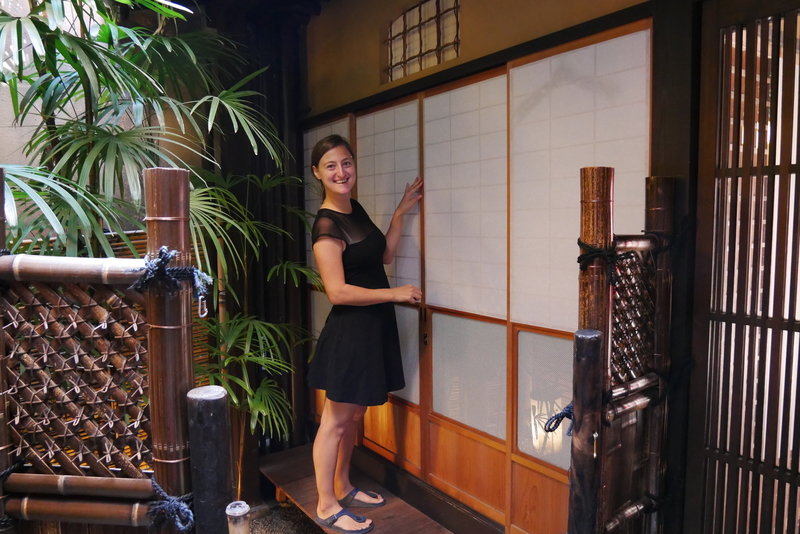
For the last day of our whirlwind itinerary, we stayed at the Yamatoya Honten Ryokan, near Osaka’s buzzing Dotombori district. It, too, contained everything we needed for a relaxing and enjoyable stay.
Kyoto Itinerary Day 1: Highlights of Japan’s Cultural Capital
There is no doubt that Kyoto is Japan’s cultural capital and spiritual heart. It is a city in which geisha shuffle between appointments, prayer chants resonate through peaceful gardens, and picturesque streets hearken back to the days of old.
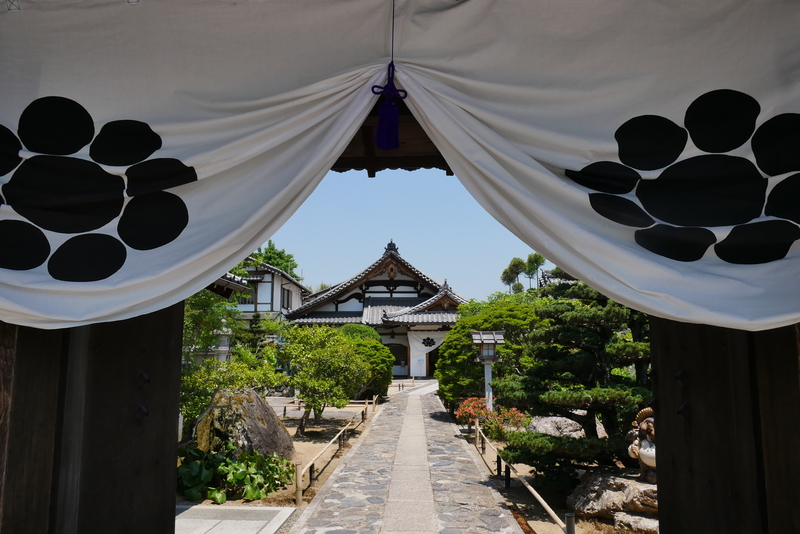
While the rest of Japan has adopted modernity with abandon, Kyoto still celebrates its heritage and clings to its past. The elegant imperial city is one of the most beautiful in Asia. It houses an unparalleled wealth of monuments, including a whopping 17 UNESCO World Heritage Sites and many of Japan’s most beloved icons.
The Golden Pavilion
The Kinkaku-Ji Temple (also known as the Golden Temple or Golden Pavilion) is the symbol of Kyoto and one of the most iconic images of Japan. It is often the highlight of Kyoto tourist itineraries.
The Golden Pavilion lies in the northwest corner of Kyoto, tucked amongst a verdant forest. The main hall of the temple complex, covered in brilliant gold leaf, casts its shimmering reflection onto an adjacent pond. At once splendid in its opulence and simple in its design, the pretty pavilion wows visitors with its delicacy
Since the Golden Pavilion is one of Kyoto’s most popular temples, I wanted to arrive early to beat the crowds. From the Kyoto Station, Dan and I hopped on bus #205 and arrived shortly after the temple’s opening time. When we arrived, however, the line already wrapped down the street. Though we were early, we realized that visiting the temple crowd-free would be an impossible feat.
Reluctantly, we joined the end of the queue and waited to pay the Y400 entrance fee.

The temple was certainly worth the wait.
The Golden Pavilion is simply stunning. Not even the crowds of tourists—numbering in the thousands—could detract from its shimmering brilliance.
The Arashiyama Bamboo Grove
Arashiyama is one of Kyoto’s most popular sightseeing districts. Filled with temples and shrines and a popular bamboo forest, the pretty district in western Kyoto merits a half day of exploration.
When I visited Kyoto in 2007, I did not stop in Arashiyama. In fact, I didn’t even know the place existed. Yet in recent years, I began seeing images of the swaying bamboo stalks everywhere—in Instagram feeds, in travel brochures and even in advertisements.
The Arashiyama Bamboo Grove has exploded in popularity over the recent years thanks, in large part, to social media.
And while I try not to let Instagram trends influence where I choose to travel, I dragged Dan to Arashiyama in order to see what all the fuss was about.
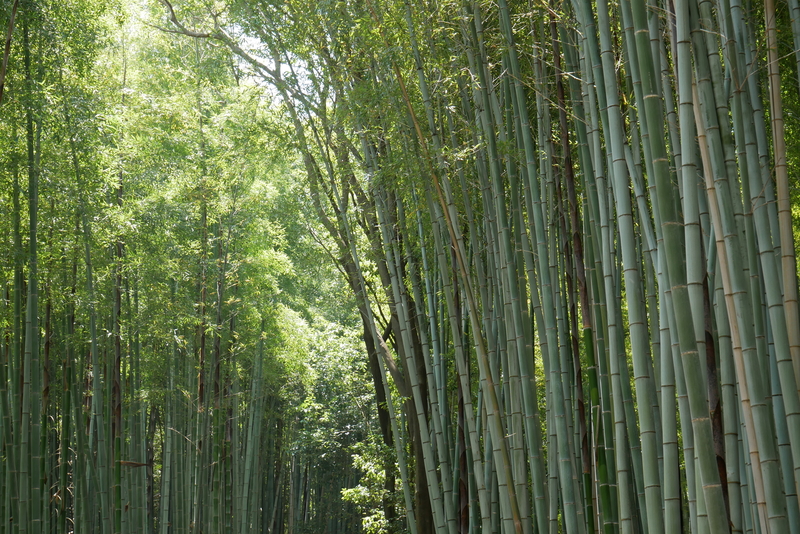
Like the Golden Pavilion, Arashiyama is worthy of its renown. The grove’s graceful bamboo pillars stretch toward the sky, rustling back and forth in the breeze and casting patterns of dappled light on the area’s pathways.
If I could go back, however, I would have stopped at Arashiyama early in the morning, en-route to the Golden Pavilion. The Arashiyama Bamboo Grove is best explored at dawn, before throngs of visitors inundate the forest with their selfie sticks and curated poses.
While Arashiyama’s bamboo forest is undoubtedly the most popular thing to see in the area, it certainly isn’t the only notable destination in Arashiyama. One could spend an entire day in the area—exploring its maze of temples, floating down the Katsura River by boat, and watching life unfold from the Togetsukyo Bridge.
The Nijo Castle
The Nijo Castle dominates a large part of Northwest Kyoto. Built in 1603 as the official residence of the city’s Tokugawa shogun, the imposing structure was meant to demonstrate prestige.
The most noteworthy attraction on the Nijo Castle grounds is the spectacular Karamon Gate. Intricately adorned in golden motifs, the wooden gate is one of Kyoto’s finest examples of artisanship.
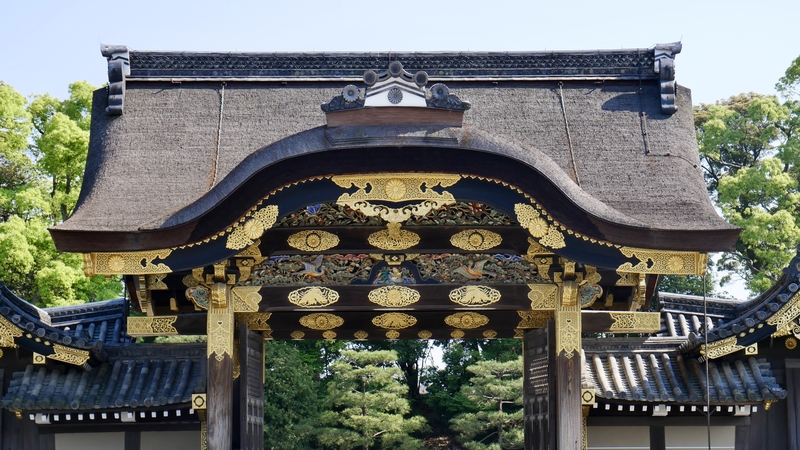
The Nijo Castle complex is divided into five principal buildings. The fourth chamber contains spectacular golden screen paintings that showcase the delicate sophistication of Japanese art.
Photography of the screen paintings is, unfortunately, prohibited.
The Nishiki Market
After soaking in three of Kyoto’s most important sites and completely skipping out on lunch, Dan and I were ravenous. We decided to take a bus from the Nijo Castle to the Nishiki Market for dinner.
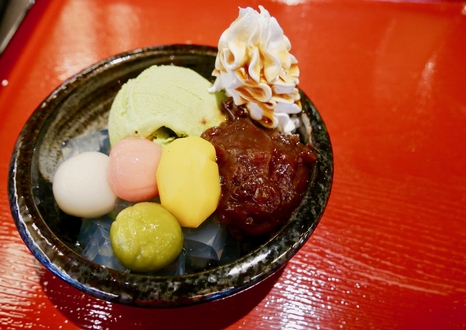
The Nishiki Market—also known as Kyoto’s Kitchen— is a favorite spot for locals and tourists alike. Filled with souvenir stalls, street food, cafes, restaurants and matcha shops, the sprawling covered market is Kyoto’s top foodie hotspot and a great place to sample the city’s local delicacies.
Kyoto Day 2: A Taste of Traditional Japan
On the following day, Dan and I continued our quest to discover Kyoto’s most beautiful religious monuments. We began our day with a hike around the grounds of the sprawling Fushimi Inari Shrine. In the afternoon, we explored the traditional streets and alleyways that serve as a peephole into Kyoto’s past.
The Fushimi Inari Shrine
With a seemingly endless string of orange torii gates spread across a thickly wooded mountainside, the Fushimi Inari Shrine represents a one-of-a-kind temple-going experience. The shrine is, quite simply, one of the most impressive places to visit in Japan and a must-see staple of any Kyoto itinerary.
And better yet, the Fushimi Inari Shrine doesn’t cost any money to visit.
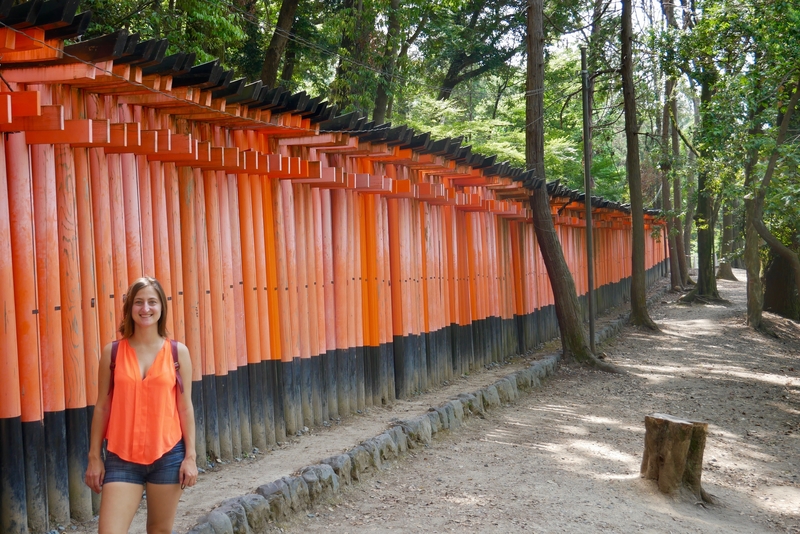
The entire religious complex sprawls across the wooded slopes of Inari Mountain. A path wanders 4 kilometers up the mountain, sheltered by thousands of vermillion archways. It is a beautiful shaded area that consists of dozens of trails, alters and small sub-shrines.
We spent a few hours exploring Fushimi Inari during the morning of our second day in Kyoto. And, had we not decided to proceed to some of Kyoto’s other must-see attractions, we could have probably spent the whole day hiking around Inari’s orange-speckled slopes.
Kyoto’s Gion District
From the Fushimi Inari Shrine, we took the Keihan Main Line to Gion. There, we turned back the clock and found ourselves meandering down the narrow lanes of Medieval Japan.
Gion is one of Kyoto’s most beautiful neighborhoods. The picturesque district dates back to the Middle Ages. It is one of the top places to visit in Kyoto and, by far, the most famous geisha district in Japan.
In Gion, it is not uncommon to see geisha shuffling along narrow streets, flitting to and from their latest appointments.
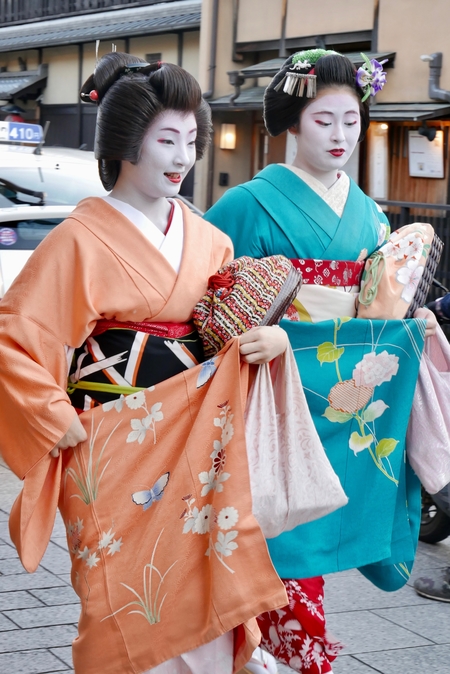
Packed with bars, restaurants and traditional teahouses, Gion lies between the Nishiki Market and Yasaka Pagoda. Some of Gion’s most picturesque strolling spots include Hanami Lane, Shijo Dori and the Shirakawa Canal.
A visit to the area is best combined with a walk through the nearby Higashiyama District between the Yasaka Shrine and Kiyomizu-dera Temple.
The Higashiyama District
The Higashiyama District lies along the lower slopes of Kyoto’s eastern mountains. Like nearby Gion, it is one of the city’s best preserved historic districts.
Small shops, cafes and restaurants line Higashiyama’s pretty streets. Its businesses retain their centuries-old designs and entice customers with delectable sweets, local handicrafts and Japanese curiosities.
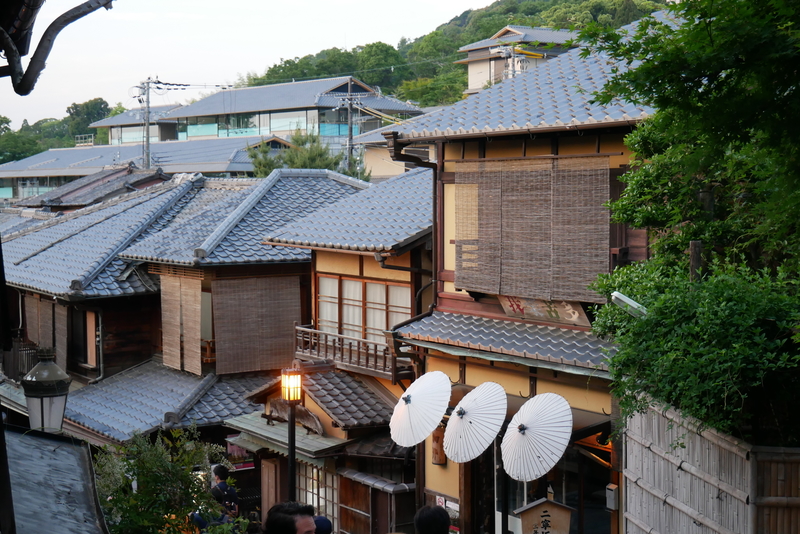
The Yasaka Pagoda is a defining landmark that lies between Gion and the Higashiyama District. From the pagoda, a well-preserved walk leads to the sprawling Maruyama Park in one direction, and the iconic Kiyomizu-Dera temple in the other.
The Kiyomizu-Dera Temple
A buzzing hive of activity perched on a hill overlooking Kyoto, Kiyomizu-Dera is one of the city’s most important temples. As with the impressive Orthodox cathedral in Karakol, Kyrgyzstan , the temple was built without the use of a single nail.
Kiyomizu-Dera’s main hall contains a verandah that juts out over the hillside. Below its main hall is a fountain from which visitors can drink water and pray for longevity and good fortune.
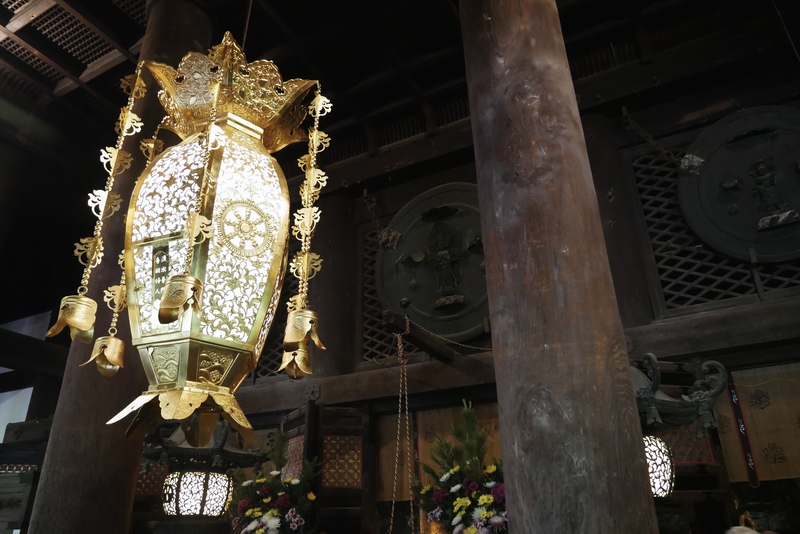
I distinctly remember visiting Kiyomizu-Dera twelve years ago and soaking in the aerial views of Kyoto from its reinforced wooden balcony.
When I visited the temple on my most recent trip to Kyoto, however, the main temple structure was unfortunately wrapped in scaffolding.
Nonetheless, visiting Kiyomizu-Dera was well worth the Y300 entrance fee.
Japan Itinerary Day 3: Exploring Osaka
Osaka is the second largest city in Japan. While it doesn’t have the same high concentration of UNESCO sites and cultural gems that can be found in Kyoto, the cosmopolitan city is well known for its nightlife, business districts and incredible street food. Osaka is Japan’s food capital writ large, boasting an overwhelming number of mouthwatering culinary delicacies.
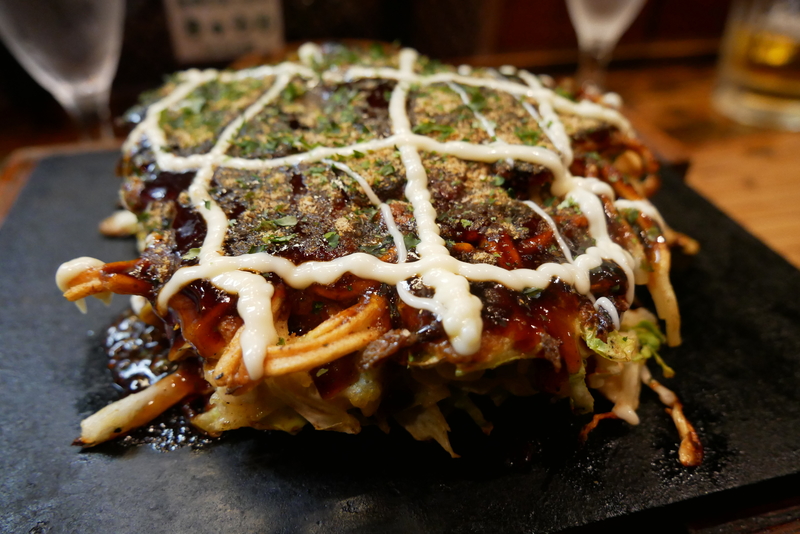
Osaka is not pretty in the conventional sense, but it packs more color than most cities—exhibiting vibrant pedestrian walkways and concrete buildings blanketed in flashy neon signage.
As with Kyoto, I could have spent the entirety of my Japan vacation in Osaka and still found plentiful things to do and foods to eat. With only one day, however, I decided to divide my time between the colorful foodie paradise of Dotombori, and the magnificent Osaka Castle in the Chuo-Ku District.
The Osaka Castle
The Osaka Castle has become a symbol of Japan. It is, without a doubt, the top place to visit in Osaka.
After unifying Japan in the late 1500s, General Toyotomi Hideyoshi built this grand castle alongside 100,000 workers. And though the present structure is a 1931 concrete reconstruction of the original, the current castle is nonetheless an impressive site to behold.
The five-story building sits in the middle of a large park and looms dramatically over Osaka’s surrounding cityscape.
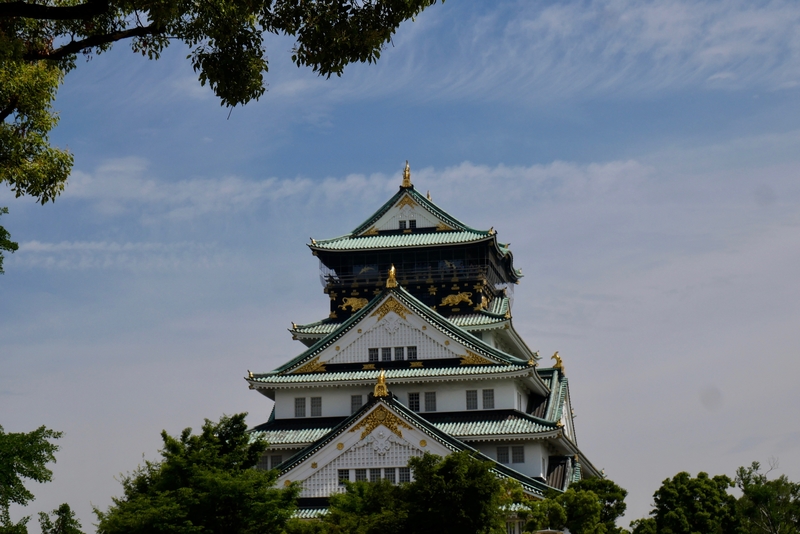
The entire Osaka Castle Park covers about two square kilometers in the northern part of the city. The park contains sports facilities and vast areas of green space. During the springtime, it is one of Osaka’s most popular places for hanami-viewing .
Street Food and Neon Lights in Dotombori
Dan and I ended our Kyoto and Osaka itinerary with a stroll through the dynamic Dotombori District.
Highly photogenic Dotombori contains a large concentration of Osaka’s foodie hotspots. It is a lively area, made all the more atmospheric at night, when it is illuminated in flashing neon signs that resemble parts of Tokyo, Hong Kong , New York and Seoul.
A 400-year-old canal cuts through the flashy district. At night, illuminated billboards (including that of the famous Gilco Running Man) emit a show of lights that glitter off its waters.
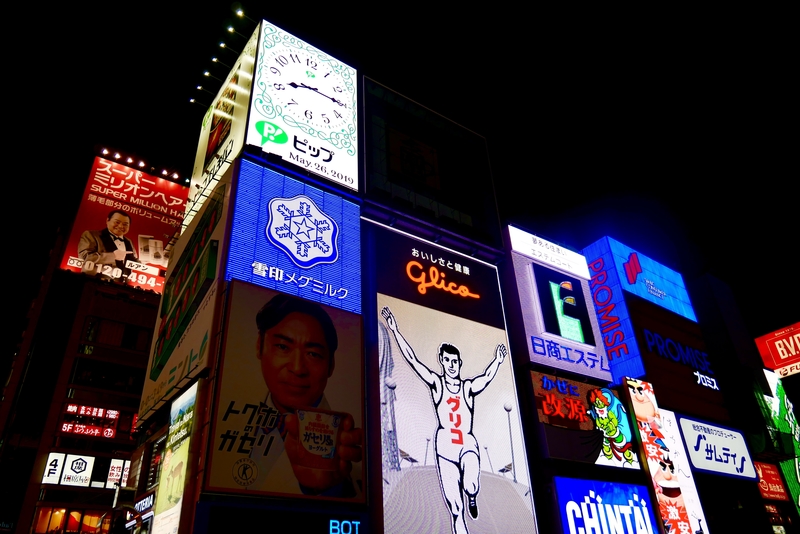
Heeding the advice of multiple blogs and travel guides, we explored the district with empty stomachs and put our taste buds to work. We ate okonomiyaki along one of Dotombori’s hole-in-the-wall side streets, sampled takoyaki from kukuru and snacked on an assortment of Osaka-style skewers at Kushikatsu Gokakuya.
I wish I could have eaten without getting full, because the food options in Osaka kept my mouth watering long after I’d stuffed my stomach to the brim.
My three day Kyoto and Osaka itinerary allowed me to experience some of Japan’s best offerings in limited time. From iconic landmarks and world heritage sites to tantalizing food and vibrant culture, Kansai’s two largest cities gave me insight into the contrasting forces at play in this modern, yet deeply traditional, country.
And in doing so, they all but convinced me to begin planning my return trip to the area.
___________________________
Additional Kyoto and Osaka Itinerary Tips
- There are multiple ways to travel between Kyoto and Osaka. The shinkansen (Y1420) is the fastest option, taking approximately 15 minutes. Other options include the JR Train (Y560, 30 minutes) and a bus that travels between Kyoto Station and Osaka’s Universal City Station (Y900).
- Visiting Kyoto and Osaka is best in the Spring and Fall, when weather is pleasant and mild. Summers in Japan can get unbearably hot, while winters tend to be quite cold.
_______________________________
Like this Osaka and Kyoto Itinerary? Pin it!
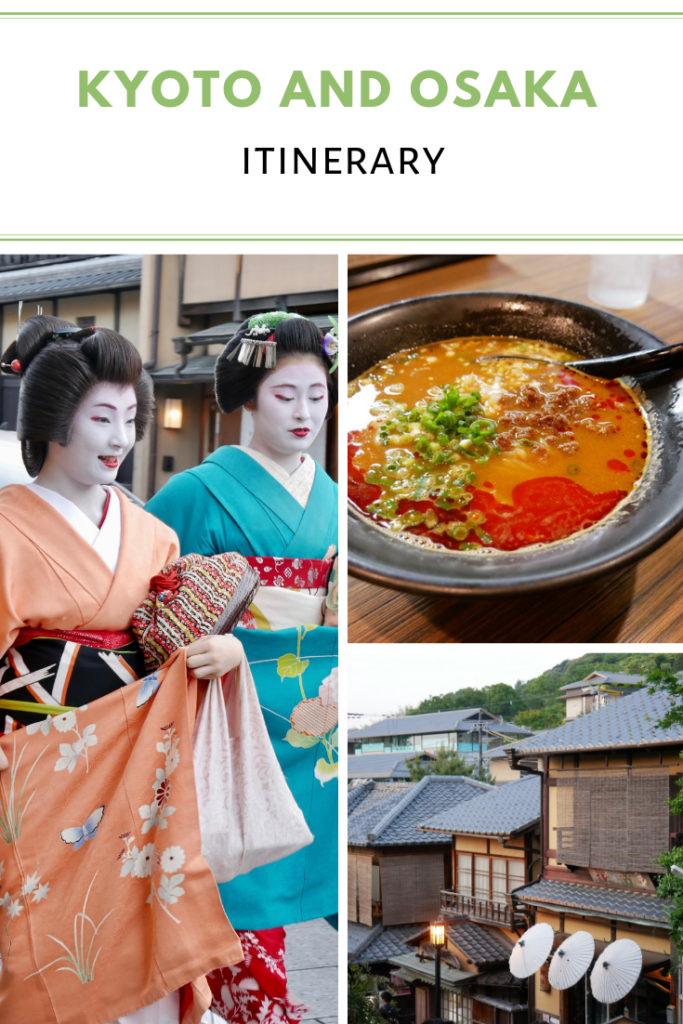
- Skip to main content
- Skip to primary sidebar

Destinations
- Plan Your Trip
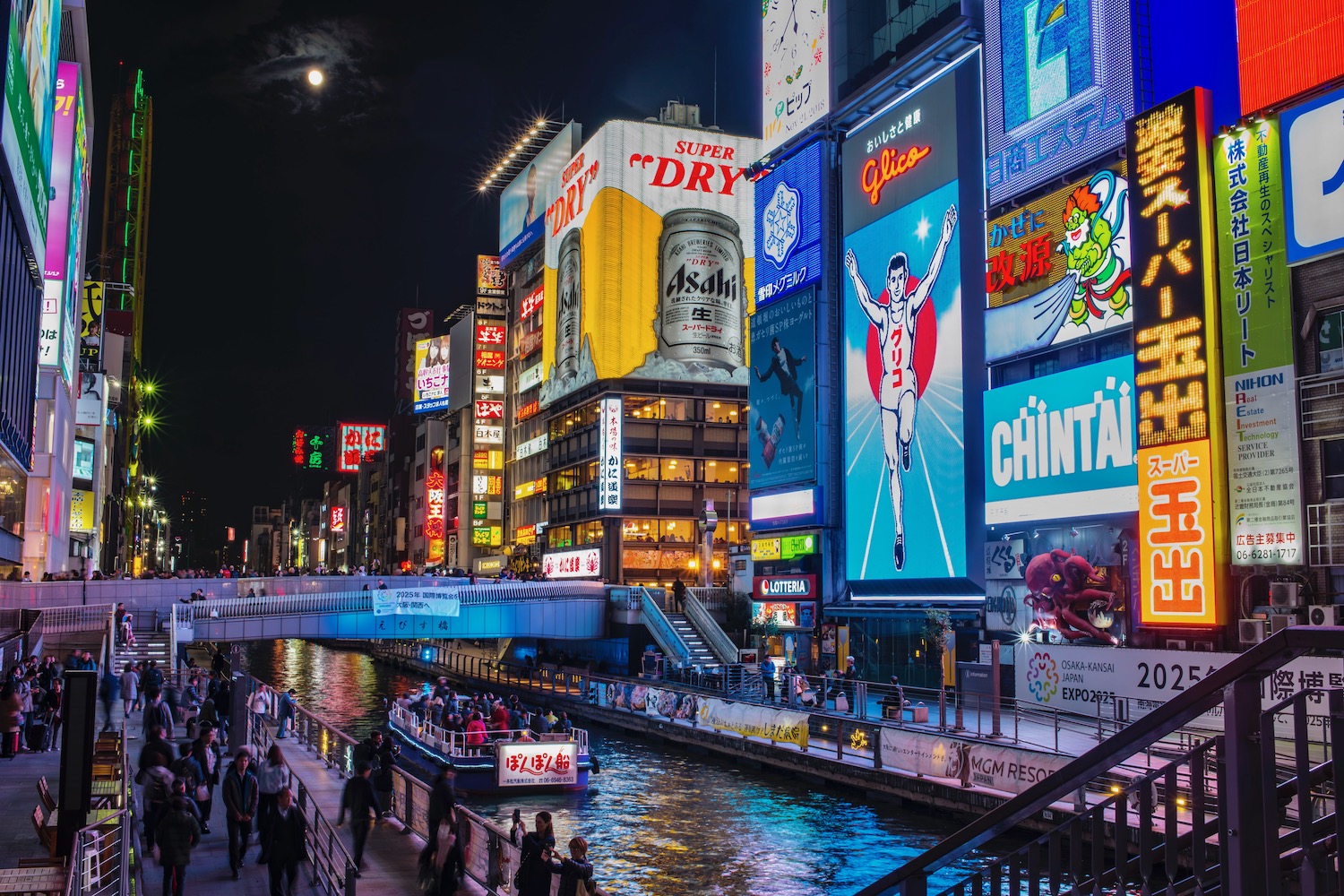
The Fastest Way Between Kyoto and Osaka
June 8, 2023 by Robert Schrader Leave a Comment
Today—the day I’m writing this—on Twitter, I came across a dubious tweet . While obviously well-intentioned, it use the example of the “bullet train from Kyoto to Osaka” to illustrate the amazingness of public transportation in Japan.
Notwithstanding the fact that JR has actually been a private company for decades, there’s another major flaw with this tweet: The Shinkansen , in almost all cases, is neither the best nor even the fastest way to travel from Kyoto to Osaka.
No matter which stage of research you’re at, I think you’ll find this post helpful—and not just within the specific context of Japan’s Kansai region. The bullet train is wonderful, and undoubtedly fast, but simply isn’t always the best way to get from Point あ to Point び in Japan.
Why You Shouldn’t Take the Bullet Train from Kyoto to Osaka
Of all the ways to travel from Osaka to Kyoto, the Shinkansen is probably the worst option. Here’s why:
- It takes you to Shin-Osaka Station , which is far north of Osaka’s city center. You’ll need to transfer to the Osaka Metro Midosuji Line to get anywhere worth seeing, destroying any perceived time advantage.
- It leaves from Kyoto Station , which is not the area where most tourists in Kyoto stay (i.e. Higashiyama and Arashiyama ).
- While it’s covered by the Japan Rail Pass , it isn’t included with the JR Kansai Wide Area Pass , or other regional rail passes.
- It’s expensive if you pay outright: ¥2,870 (which is just to Shin-Osaka ; the Midosuji Line requires payment of an additional fare) vs just ¥580 for the normal JR Lines .
Unless you’re taking the bullet train simply because it’s the only opportunity you have to ride one during your trip (which is doubtful), there are many better ways to make this journey.
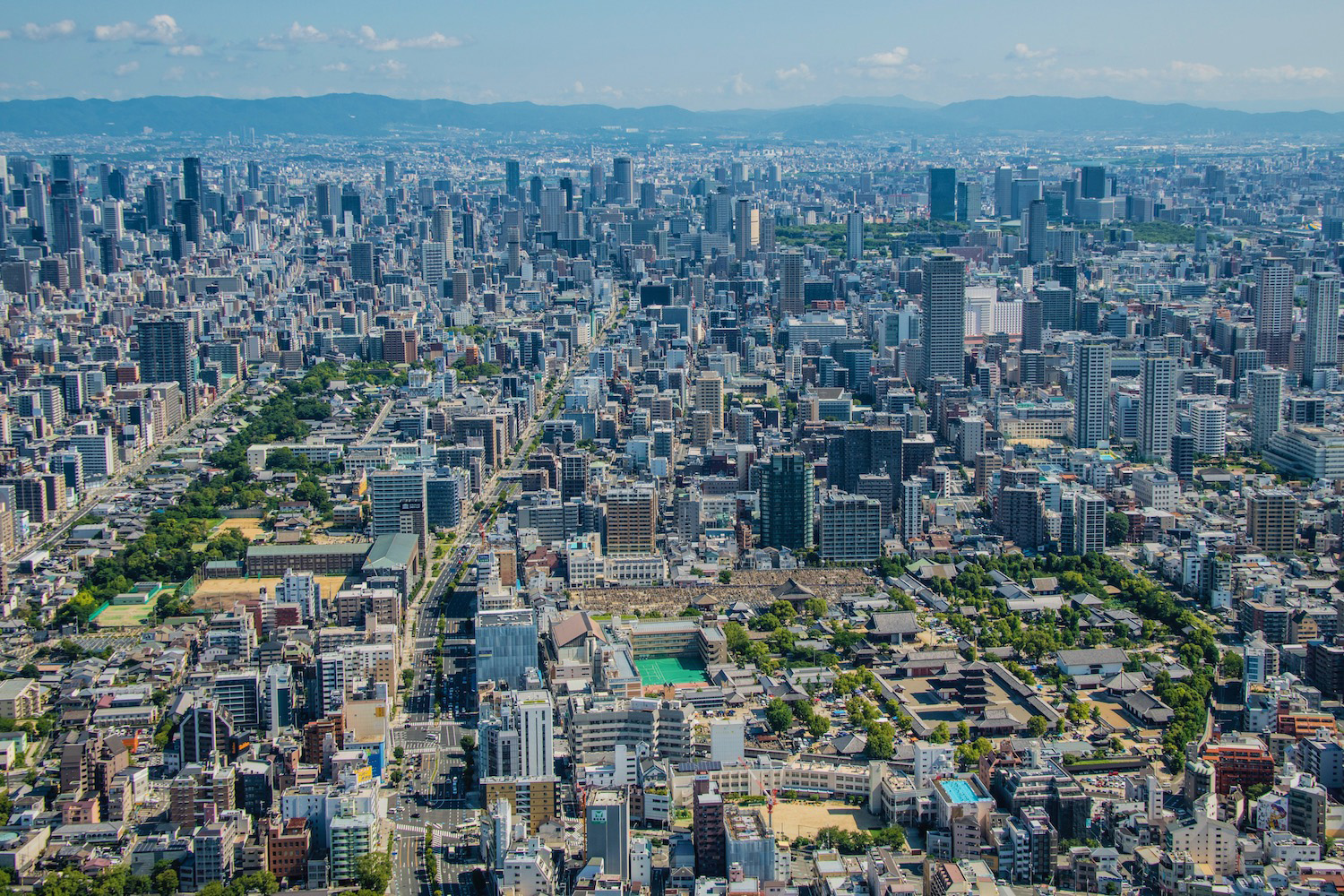
The Best Ways to Go Between Osaka and Kyoto
Keihan line.
For me, this is the most underrated (and maybe) the best way to Osaka, if you’re in Kyoto. The Keihan Line departs from stations in Higashiyama— Sanjo , Gion-Shijo and Kiyomizu-Gojo , from north to south; it runs to Osaka’s Yodoyabashi Station , which is halfway between Umeda and Namba . You can also get off at Kyobashi , which is just a short walk from Osaka Castle . The only downside? You can’t use a JR Pass, although you can use PASMO , Suica , ICOCA and other IC (stored value) cards.
JR Special Rapid Service
If you absolutely have to use a JR Pass to travel from Kyoto to Osaka, skip the Shinkansen and instead enter the normal JR tracks. The platform varies (it’s often, but not always, #8 ), but what you’re looking for is a Special Rapid Service , bound either for Osaka , Sannomiya or Himeji —you’ll get off in Osaka, regardless of the final destination. This takes you directly to Osaka Station , in just a few minutes more than a Shinkansen would take you to Shin-Osaka.
Hankyu Line
Another option, if you’re not married to your JR Pass, is the Hankyu Line . While you can technically depart (and travel directly) from Kyoto-Kawaramachi Station near Nishiki Market , this train is mostly useful to me when coming from Arashiyama . This requires a change—you’ll ride the Hankyu Arashiyama Line to Katsura , then transfer to the Hankyu Main Line and ride it to Hankyu Osaka-Umeda —but is effectively a straight shot from Arashiyama to Osaka.
Shinkansen + Midosuji Line
If you’re absolutely set on taking the Shinkansen , I will now stop trying to change your mind. However, you once again have to keep in mind that this won’t take you to Osaka’s city center (or from, if you’re traveling from Osaka to Kyoto). Rather, you’ll need to ride the Osaka Metro Midosuji Line . The good news is that this can take you to most top Osaka destinations, including Umeda , Namba and Tennoji . Get off in Umeda to connect to the Osaka Loop Line , which takes you to Osaka Castle .
“Back ways” to Osaka
Did you know that going directly from Kyoto is not always the best way to reach Osaka, even on a day trip? For example, if you also want to visit Himeji Castle or Kobe , you might hit those up first and then travel from there to Osaka (again, a JR Special Rapid Service is preferable to the Shinkansen ). Likewise, you could enjoy an evening eating street food in Osaka after a day feeding deer in Nara ; in this case you would ride the JR Yamatoji Line from Nara to Tennoji or Osaka .
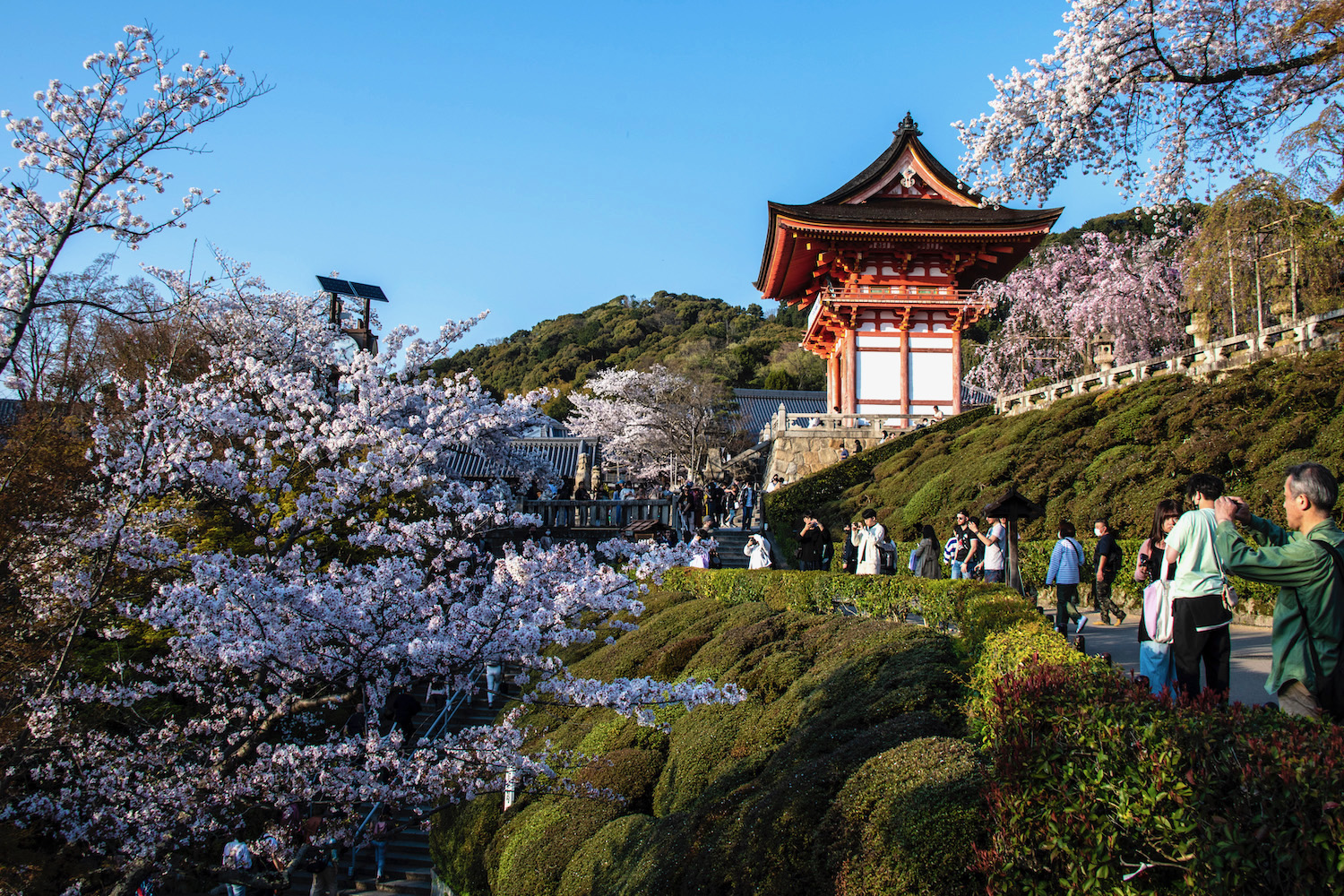
How to Travel from Kyoto to Osaka’s Airports
Did you know that it’s not possible to fly to Kyoto? Kyoto doesn’t have an airport. If you plan to come to or depart from Kyoto by plane, you’ll need to use one of Osaka’s two airport: Itami (which is all-domestic and closer to to the city), or the farther-out Kansai International (which also handles some domestic flights). If you want to reach KIX , the best way is to take the Haruka Limited Express , which departs from Kyoto Station and is fully covered by the Japan Rail Pass.
For traveling between Kyoto and Osaka-Itami, meanwhile, the most efficient way is a Limousine Bus . This leaves from the Hachijo-guchi Bus Stop just south of Kyoto Station (it’s right in front of Nakau restaurant). While reservations are neither possible nor necessary, you should buy an advance ticket from the machine on the street corner (¥1,340), unless you plan to use an IC card like PASMO , Suica or ICOCA .

Other FAQ About Travel from Kyoto to Osaka
How much is the bullet train from kyoto to osaka.
If you ride the bullet train from Kyoto to Shin-Osaka (which is the only Shinkansen station service Osaka), you’ll pay ¥2,870, assuming you don’t have a JR Pass. If you do hold a pass, this journey is covered. Keep in mind, however, that you’ll need to ride the Osaka Metro Midosuji Line to get from Shin-Osaka into the city center; this requires payment of additional fare.
How do I get from Kyoto Station to Osaka?
In my opinion, the best way to get from Kyoto Station to Osaka is to ride a JR Line Special Rapid Service. This ordinary train connects you to Osaka Station (i.e. the city center) in less than 30 minutes, and costs just ¥580. While neither as futuristic as the Shinkansen nor as comfortable (there are no assigned seats), this is by far the best way from Kyoto Station to Osaka’s city center.
Can Osaka be a day trip from Kyoto?
Osaka can absolutely be a day trip from Kyoto, even though I do recommend that you stay overnight in Osaka if you can swing it. Mechanistically, I recommend riding a JR train from Kyoto to Osaka Station, then using the Osaka Loop Line to visit Osaka Castle and Shi-tennoji temple. End the night with street food along Dotonbori Canal, then ride the Keihan Main Line from Yodoyabashi Station back to Kiyomizu-Gojo, Gion-Shijo or Sanjo Stations in eastern Kyoto.
The Bottom Line
Traveling from Kyoto to Osaka isn’t (typically) a matter of boarding a bullet train. If you’re using a Japan Rail Pass, you’ll want to instead ride a JR Line Special Rapid Service, which takes you directly from Kyoto Station to Osaka Station. If you’re coming from Higashiyama or Arashiyama, meanwhile, the non-JR Keihan and Hankyu Rail Lines are probably the best options. In still other cases, you might not even visit Osaka directly from Kyoto, and will take a “back way” to the city instead. No matter what shape your trip eventually ends up taking, I do hope you’ll consider hiring me to plan it .
Osaka → Kyoto

Was the information on this site useful?
Insufficient content
Thank you for your response. We will continue to strive for improvement in quality.
Login or Register
Reset password, create account.
Please agree to the Privacy Policy and Terms and Conditions of Use before proceeding.

All the insider's travel tips in Korea
Shopping List: Top 8 Things to Buy in Osaka & Kyoto
If you’re planning a trip to Japan , you’ll want to leave plenty of room in your suitcase for souvenirs. From city shopping across Osaka ‘s various districts to traditional trinkets & memorabilia from Kyoto , there’s easily another suitcase worth of goodies you’ll want to bring back with you!
In fact, Japan even has a unique souvenir gifting practice called omiyage . The word omiyage (お土産) refers to gifts or souvenirs that travelers bring back from their trips for friends, family, and colleagues. However, unlike personal souvenirs, omiyage are specifically meant to be shared with others and are considered a social obligation in Japan.
- Secure your phone data for Japan with an [Android/iPhone] Japan 4G Data Only eSIM (15~30 days) !
- Travel around Kansai hassle-free with a Kyoto-Osaka Sightseeing 1-Day Pass (Osaka Metro Version) !
In this blog, we’ll take you through the top must-buy souvenirs from Osaka & Kyoto to get on your next trip to Japan, both for yourself and any omiyage for your friends & family back home.
Osaka offers a vibrant souvenir shopping experience, featuring a diverse array of unique items that highlight the city’s culinary delights and quirky culture, such as takoyaki-inspired snacks, traditional sweets, and playful novelty gifts.
1) Takoyaki-Inspired Snacks

In Osaka, takoyaki-inspired snacks offer a fun twist on the city’s iconic dish. These include takoyaki-shaped cookies and chocolates, which capture the visual appeal of the original, as well as snacks like Takoyaki Koro Koro, a crispy treat resembling the savory octopus balls but in a smaller, spicier form. Another popular option is Jagariko, a potato snack available in a unique takoyaki flavor, exclusive to the Kansai region.
2) Osaka no Koibito Cookies
View this post on Instagram A post shared by หิ้วญี่ปุ่น ขนมญี่ปุ่น ยาญี่ปุ่น🇯🇵✨ (@yp.house)
Osaka no Koibito cookies are a playful homage to the famous Shiroi Koibito from Hokkaido, featuring a delightful combination of creamy white chocolate sandwiched between two crisp, buttery langue de chat biscuits. These cookies are smaller and more bite-sized than their Hokkaido counterpart, making them easy to enjoy. The packaging often includes humorous phrases in the Osaka dialect, adding a local touch that resonates with visitors.
3) Rikuro’s Cheesecake
View this post on Instagram A post shared by Kirsten van Loozen-Leavitt (@kirsten_vibes)
Rikuro’s Cheesecake , is a beloved dessert from Osaka, renowned for its light, fluffy texture and mild flavor. Each 18 cm cheesecake is freshly baked on-site, featuring a unique combination of high-quality cream cheese imported from Denmark and sweet raisins at the bottom. Priced affordably, it has gained popularity as a must-try souvenir for visitors, often characterized by its satisfying jiggle and melt-in-your-mouth quality.
Kyoto offers a blend of traditional crafts, specialty foods, and modern goods, with popular items including Yatsuhashi sweets, Kyo Yaki ceramics, and exquisite textiles, all found in vibrant districts like Nishiki Market and along Shijo Street.
1) Yatsuhashi
View this post on Instagram A post shared by Nami | Just One Cookbook® (@justonecookbook)
Yatsuhashi is a traditional Japanese sweet from Kyoto, made primarily from glutinous rice flour and sugar. There are two main types: Nama Yatsuhashi , which is soft and chewy, often flavored with cinnamon or matcha, and Baked Yatsuhashi , which is crispy and typically flavored with cinnamon.
2) Kyo Yaki & Kiyomizu Yaki Ceramics
View this post on Instagram A post shared by 陶葊(陶あん) – 京焼・清水焼の窯元 (@touan1922)
Kyo Yaki (Kyoto ware) is an umbrella term for pottery produced in Kyoto, dating back to the late 5th century. It encompasses a wide variety of styles and techniques, known for its elegant forms and originality. Kiyomizu Yaki is a subcategory of Kyo Yaki, specifically referring to ceramics produced in the vicinity of Kiyomizu Temple. These ceramics range from everyday items like plates and teacups to decorative pieces, each showcasing the craftsmanship and artistic traditions of Kyoto.
View this post on Instagram A post shared by 抹茶_紋【抹茶スイーツ/東京カフェ/手作りレシピ】 (@matcha_aya)
Matcha is a high-quality green tea powder made from shade-grown tea leaves. It is well-known for its vibrant color, rich flavor, and various health benefits. Originating from the Uji region near Kyoto, it is traditionally used in Japanese tea ceremonies.
4) Yojiya Cosmetics
View this post on Instagram A post shared by よーじや【公式】 (@yojiya_official)
Yojiya Cosmetics , founded in Kyoto in 1904, is renowned for its high-quality beauty products that blend traditional Japanese aesthetics with modern skincare needs. The brand is particularly famous for its oil-blotting facial paper, which effectively absorbs excess oil without disturbing makeup.
5) Kyoto Pickles
View this post on Instagram A post shared by Kitamura Rin_kyoto (@kitamura.rin)
Kyoto pickles, or Kyo Tsukemono , are a traditional Japanese food that showcases the region’s unique vegetables and pickling techniques. These pickles are lightly salted and often fermented and include multiple varieties such as Senmaizuke, Shibazuke, and Suguki.
Check out these other things to do in Osaka & Kyoto:
- Osaka Tombori River Cruise Ticket
- Osaka Tsutenkaku Tower Observation Deck Admission Ticket
- Osaka Private Walking Tour & Kimono Experience with Licensed Guide
- LEGOLAND Discovery Center Osaka Admission Ticket
- Kyoto & Nara 1 Day Tour from Osaka/Kyoto
- Kobe Mt. Rokko Night View & Kitano Ijinkan & Arima Onsen Tour 1 Day Tour from Osaka
- Kyoto Private Walking Tour & Kimono Experience with Licensed Guide
Discover more of the best things to do in Japan, visit Trazy.com , Your Travel Shop for Asia !

Leave a Reply Cancel reply
Your email address will not be published. Required fields are marked *
This site uses Akismet to reduce spam. Learn how your comment data is processed .
- All about SIM Card
- All about WiFi
- Korea Travel Itineraries
- Getting Around Korea
- National Holidays
- Top 10 Things to Do
- Deoksugung Palace & Jeongdong Walking Tour
- Secret Garden & Bukchon Hanok Village Walking Tour
- Seoul K-drama Shooting Spots Walking Tour
- Namsan Park & N Seoul Tower Evening Hiking Tour
- Seoul City Wall & Ihwa Mural Village Walking Tour
- Seochon Village Walking Tour
- Seoul Hiking Tour: Inwangsan & Bugaksan
- Everland Guide
- Everland Ticket & Packages
- Lotte World Guide
- Discount Tickets
- Han River Cruise Guide
- Han River Cruise Ticket
- Hanbok Rental Service
- Hanbok Rental Guide
- Nami Island Guide
- Nami Island Tours
- The Garden of Morning Calm
- DMZ & JSA
- DMZ & JSA Tours
- Mt. Seoraksan
- Jeju Popular Attractions
- Busan Popular Attractions
- Rest of Korea
- Cherry Blossoms
- Spring Must-Dos
- Water Activities
- Summer Must-Dos
- Autumn Foliage
- Autumn Must-Dos
- Ski & Snowboard
- Winter Must-Dos
- Festivals & Events
- K-Pop & K-Drama
- K-Beauty Guide
- Visit Trazy.com
- General Tips
- Beauty, Hair & Skin Care Service
- Korea Shopping Guide
- Food & Restaurant Guide
- Cooking Class & Food Tours
- Survival Tips
Related Post
Top 11 must-do experiences in kyoto, top things to do at tokyo skytree, best 5 indoor activities to do in osaka on a rainy day, 5 must-visit unique cafes in tokyo, top 5 omakase restaurants in tokyo, shopping list: top 16 things to buy in tokyo.
More From Forbes
A guide to exploring tokyo and kyoto, japan.
- Share to Facebook
- Share to Twitter
- Share to Linkedin
Yasaka Pagoda and Sannen Zaka Street in Kyoto, Japan.
Japan is a country that seamlessly blends the old with the new, offering travelers a unique opportunity to experience its rich history alongside its cutting-edge modernity. Two cities that epitomize this balance are Tokyo and Kyoto. Tokyo, the bustling capital, is a vibrant metropolis filled with skyscrapers, neon lights, and a nonstop energy. Kyoto, the former imperial capital, is a serene city known for its ancient temples, traditional tea houses, and picturesque gardens. Together, these cities offer a comprehensive glimpse into Japan’s diverse cultural landscape.
Exploring Tokyo
The Shibuya shopping district in Tokyo, Japan.
Tokyo is a city of neighborhoods, each with its own distinct character and charm. Shibuya, for instance, is famous for the iconic Shibuya Crossing, where travelers can witness the organized chaos of thousands of people crossing the street simultaneously. This district is also a hub for fashion, youth culture, and entertainment, with many shops, cafes, and nightclubs.
Senso-ji Temple, Asakua, Japan.
Just a short train ride away is the historic district of Asakusa, where travelers can step back in time and explore the city’s more traditional side. The highlight here is Senso-ji, Tokyo’s oldest temple, which is approached via the bustling Nakamise shopping street. Here, you can purchase traditional Japanese snacks and souvenirs, making it a must-visit for anyone interested in the cultural history of Japan.
Best High-Yield Savings Accounts Of 2024
Best 5% interest savings accounts of 2024.
The Sagamu food tour includes tastings of many local, traditional sweets.
For those looking to delve into Tokyo’s vibrant culinary scene, the Local Foodie Adventure Tour in Sugamo is a fantastic way to taste authentic Japanese cuisine. Sugamo, often referred to as the “Old Ladies’ Harajuku,” is a charming neighborhood known for its traditional shops and eateries. The tour guides visitors through local markets and food stalls, offering a taste of everything from street food to traditional sweets.
The teamLab Borderless Digital Art Exhibition in Tokyo.
Another unique experience in Tokyo is the teamLab Borderless Digital Art Exhibition. This immersive digital art museum blurs the boundaries between the viewer and the art, creating an interactive experience where you become part of the installation. The museum features rooms filled with vibrant projections, where the environment shifts and changes with your movements, offering a mesmerizing experience unlike any other.
Kayaking in Tokyo gives a different perspective of the city.
For a different perspective of the city, consider taking a kayak tour of Tokyo. This activity allows you to paddle through the city’s waterways, offering a tranquil escape from the urban hustle. The route provides stunning views of Tokyo’s skyline and iconic landmarks, giving you a chance to see the city from a unique vantage point.
No visit to Tokyo would be complete without exploring its pop culture—two hotspots include Harajuku and Akihabara. In Harajuku, you’ll find the latest fashion trends and quirky shops, while Akihabara is a paradise for fans of anime, manga, and video games.
Hotel Groove Shinjuku, in Tokyo, Japan.
While there are no shortage of hotels in Tokyo, the recently opened Hotel Groove Shinjuku centrally located in the vibrant district of Shinjuku, this contemporary hotel offers modern amenities and stylish rooms. Its central location makes it a convenient base for exploring the city, with easy access to Shinjuku’s bustling shopping and entertainment areas. The hotel’s on-site restaurant, JAM17, offers a delightful dining experience, blending Japanese and Western cuisines with a focus on fresh, locally sourced ingredients.
Exploring Kyoto
The Bamboo Forest in Kyoto, Japan.
While Tokyo dazzles with its modernity, Kyoto captivates with its timeless beauty and cultural heritage. As Japan’s capital for over a thousand years, Kyoto is the heart of traditional Japanese culture. Kyoto is home to an incredible number of temples, shrines, and historic sites, each offering a glimpse into Japan’s rich spiritual and cultural history. One of the most famous is Kinkaku-ji, the Golden Pavilion, a stunning Zen temple covered in gold leaf that reflects beautifully in the surrounding pond. Another must-visit site is Fushimi Inari Shrine, known for its thousands of red torii gates that form a pathway up the mountain, creating a breathtakingly serene atmosphere.
Maikos walking on in Gion, Kyoto.
The historic district of Gion is another highlight of Kyoto. Known as the center of Kyoto’s geisha culture, Gion is filled with traditional wooden machiya houses and narrow streets that transport you back in time. It’s a wonderful place to explore on foot, particularly in the evening when the lanterns are lit, casting a soft glow over the streets.
Staying at Machiya Residence Rikyu-An offers a unique opportunity to experience traditional Japanese living. This beautifully restored machiya, or wooden townhouse, is located in the heart of Kyoto and provides an authentic and immersive experience. With tatami-mat rooms, sliding shoji screens, and a tranquil inner garden, Rikyu-An combines the charm of old Kyoto with modern comforts.
Food tours are popular excursions in Kyoto.
For food lovers, the Pontocho Evening Food Tour is a good option. Pontocho is one of Kyoto’s most famous dining districts, known for its narrow alleys and traditional wooden buildings. The tour takes you to several local izakayas and restaurants, where you can sample Kyoto’s famous kaiseki cuisine, yakitori, and more. It’s a fantastic way to experience the local food culture while enjoying the vibrant atmosphere of Pontocho.
Traditional Japanese tea ceremony.
A popular activity for many tourists to Kyoto is a traditional Japanese tea ceremony. The Tea Ceremony at Camellia Teahouse is located in the heart of Kyoto, and provides an intimate setting where you can participate in a tea ceremony led by a skilled tea master. You’ll learn about the rituals and techniques involved in preparing matcha (powdered green tea) and have the opportunity to savor the delicate flavors of the tea along with traditional Japanese sweets.
Planning a tour to Japan
Most Japan tours start or end in Tokyo.
While some people prefer booking their travel ala cart (hotels, activities, train travel), others prefer to book with an agency. One option is InsideJapan Tours , which was founded by two Japanophiles, Alastair Donnelly and Simon King. Here’s how it works. The agency creates an itinerary based on the requests of the traveler. The itinerary can be in-depth and include hotels, activities, train tickets and more (with each day planned out from morning to night) or can be more a frame-work (with hotels planned and suggestions made in terms of activities).
When including activities in the itinerary, the agency can include Insider Experiences which range from video game tours, an insider’s look at the world of sumo wrestling, Tokyo’s Manga and Anime scene, Kyoto’s gardens tours and Gion’s geisha culture.
One of the key strengths of InsideJapan Tours is their deep knowledge of the country. Their team of experts includes both expatriates who have lived in Japan for years and native Japanese staff. The Insider Experiences are all led by native English-speaking guides, who are also fluent in Japanese and currently live in Japan.

- Editorial Standards
- Reprints & Permissions
Join The Conversation
One Community. Many Voices. Create a free account to share your thoughts.
Forbes Community Guidelines
Our community is about connecting people through open and thoughtful conversations. We want our readers to share their views and exchange ideas and facts in a safe space.
In order to do so, please follow the posting rules in our site's Terms of Service. We've summarized some of those key rules below. Simply put, keep it civil.
Your post will be rejected if we notice that it seems to contain:
- False or intentionally out-of-context or misleading information
- Insults, profanity, incoherent, obscene or inflammatory language or threats of any kind
- Attacks on the identity of other commenters or the article's author
- Content that otherwise violates our site's terms.
User accounts will be blocked if we notice or believe that users are engaged in:
- Continuous attempts to re-post comments that have been previously moderated/rejected
- Racist, sexist, homophobic or other discriminatory comments
- Attempts or tactics that put the site security at risk
- Actions that otherwise violate our site's terms.
So, how can you be a power user?
- Stay on topic and share your insights
- Feel free to be clear and thoughtful to get your point across
- ‘Like’ or ‘Dislike’ to show your point of view.
- Protect your community.
- Use the report tool to alert us when someone breaks the rules.
Thanks for reading our community guidelines. Please read the full list of posting rules found in our site's Terms of Service.

Sneak Peek! Inside Japan's 'Nintendo Museum' Opening October 2
The highly anticipated Nintendo Museum , eagerly awaited by fans worldwide, is set to open on October 2, 2024. This article provides an inside look at what you can expect from the newly unveiled Nintendo Museum . (*Top image created from Nintendo's press release) *This page includes promotional content
Opening October 2nd! What is the Nintendo Museum?
Exciting features galore inside the nintendo museum, more highlights to explore at the nintendo museum, nintendo museum admission and ticket purchase guide, a museum filled with nintendo’s passion for family fun -don’t miss it, bonus tip: if you're heading to the nintendo museum, make sure to pair your visit with a trip to usj it’s the ultimate nintendo fan experience.

The Nintendo Museum is a special place where you can explore and experience the wide variety of products Nintendo has created over the years. Located in Uji City, Kyoto Prefecture , it was built by renovating the old Nintendo Uji Ogura Plant. Since Nintendo announced this project in 2021, fans around the world have been eagerly waiting for its opening. Now, the wait is almost over—the museum is set to open on Wednesday, October 2nd. Along with the announcement, a sneak peek video was released, giving us a first look at the museum ’s interior and some of the exciting experiences it will offer, all as part of the Nintendo Museum Direct. Here, we’ll dive into what was revealed in that video. ▼ Take a look inside! Check out the video from the Nintendo Museum Direct here.
The Nintendo Museum is divided into two main areas: the second-floor exhibition space and the first floor, where you can enjoy a variety of interactive experiences. On the second floor, you'll find displays featuring the many products Nintendo has released over the years. Meanwhile, the first floor offers eight unique experiences designed around the theme, "What if we brought Nintendo's past creations to life in the modern era?" Let's have a look at each area.
2nd Floor: Discover Nintendo's History Through Exhibits!

On the second floor, you’ll find a fascinating display of every product Nintendo has created since its founding in 1889. The exhibits start with early items like Hanafuda cards, Karuta, radio-controlled toys, and batting machines, and trace the journey of how these led to iconic video game consoles like the Famicom. Each console is showcased in its own section, so you can really see how Nintendo’s innovations evolved over the years. One cool feature is that when you step into certain areas, you’ll not only see the classic game screens but also hear the iconic game music, making the experience even more immersive. Another interesting aspect is the comparison between the Japanese and international versions of consoles like the Famicom, which had different designs and packaging. You can check out all these variations side by side. As you explore, you’ll get to relive your own memories and see firsthand how Nintendo’s games and products have evolved and connected through the years.
1st Floor: Have Fun with the Giant Controller!

On the first floor, you can experience a variety of entertainment born from Nintendo’s creative spirit, reimagined with modern technology. One of the highlights is a massive interactive monitor in the center of the floor, where you can enjoy a game of Hyakunin Isshu (a traditional Japanese card game) in a whole new way, using your smartphone to interact with the display. When you enter the museum , you’ll receive an admission pass loaded with 10 virtual coins that you can use for different activities throughout the first floor. These activities include eight unique experiences, such as the "Ultra Machine SP," an indoor batting machine, or the "Zapper & Scope SP," where you use two types of light guns to shoot at Mario-themed targets. There’s also the "Big Controller," where you can play classic Famicom games using oversized controllers. Each experience offers a fun, hands-on way to explore how Nintendo’s innovative ideas have been brought to life with today’s technology.

There's still so much more to discover at the Nintendo Museum ! One of the highlights is a workshop where you can actually make your own set of Hanafuda cards, the traditional Japanese playing cards that marked the beginning of Nintendo's journey. You can also learn the rules and play the game. These workshops require same-day reservations and have an additional cost, but they offer a unique, hands-on way to connect with Nintendo’s origins.

Inside the museum , there’s also a special café that's exclusively for Nintendo Museum ticket holders. Here, you can customize your own burger by choosing your favorite ingredients, and they also offer special drinks to enjoy. For those with dietary preferences, the café provides lacto-ovo vegetarian options (which include eggs and dairy products). It’s a great spot to take a break and enjoy a meal during your visit.

There’s also an on-site shop where you can browse and purchase a variety of official Nintendo merchandise. The shop features items themed around Nintendo’s games and characters, as well as exclusive products that you can only find at the Nintendo Museum . Like the café, the shop is accessible only to those with a museum ticket, making it a special treat for visitors.
Admission to the Nintendo Museum is as follows.
- Adults (18 years and older): 3,300 yen
- Middle and high school students: 2,200 yen
- Admission: Elementary school students 1,100 yen *Free for preschool children *Children of elementary school age or younger must be accompanied by a guardian
Ticket reservations for the Nintendo Museum are handled through a lottery system. You can apply for your preferred date and time of visit through a dedicated website. If your application is successful, you’ll then proceed to pay for the tickets. As of August 20th, reservations for October and November visits have opened, and will remain open until August 31st. If you’re interested, be sure to check the website for more details and to submit your application.
For over a century, Nintendo has created a wide range of entertainment , evolving with the times but always holding onto one core belief: bringing joy to the entire family. The Nintendo Museum is a place where you can explore the company’s dedication to craftsmanship and creativity, and experience firsthand the unique spirit behind their creations. It’s a must-visit for anyone who appreciates the magic of Nintendo. Don’t miss the chance to check it out!
- Address 56 Kagurada, Ogura-cho, Uji City, Kyoto
- Nearest Station 5-minute walk from the East Exit of Kintetsu Kyoto Line's Ogura Station, and an 8-minute walk from the North Exit of JR Nara Line's JR Ogura Station.
・Hours: 10 AM to 6 PM ・Closed: Tuesdays and during the New Year's holidays (December 30th to January 3rd) Note: If Tuesday is a public holiday, the museum will be open, and it will be closed on the following Wednesday instead.
The Nintendo Museum is located in Uji City, Kyoto Prefecture , but while you’re in the Kansai area, you can also experience the excitement of Super Nintendo World at Universal Studios Japan. If you're planning a visit to the Nintendo Museum , why not make it a full Nintendo adventure by stopping by Super Nintendo World as well? It’s a perfect way to immerse yourself in the world of Nintendo!
- Address 2-1-33 Sakurajima, Konohana-ku, Osaka City, Osaka Prefecture, 554-0031
- Phone Number 0570-20-0606
・Hours: listed on the official website ・Closed: Open daily

- Area Fushimi, Uji
- Category Other Museums
Share this article.

Recommended places for you

ISHIDAYA Hanare
Kobe, Sannomiya, Kitano

Jukuseiniku-to Namamottsuarera Nikubaru Italian Nikutaria Sannomiya

Yoshida Gennojo-Roho Kyoto Buddhist Altars
Nijo Castle, Kyoto Imperial Palace

HAKUTSURU Sake Brewery Museum
Other Museums
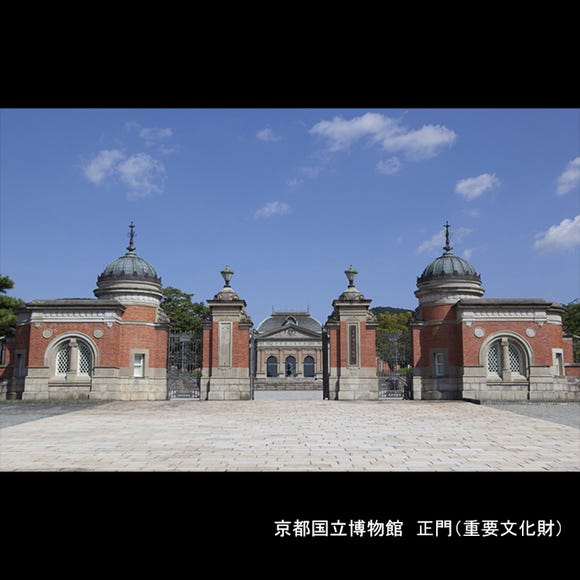
Kyoto National Museum
History Museums
Kyoto Station, To-ji Temple

Kamesushi Sohonten
Umeda, Osaka Station, Kitashinchi

11 Must-Try Restaurants Near Kiyomizu-dera Temple: From Kyoto Cuisine to Traditional Tofu Dishes and Popular Eateries
by: Wong Man Yee

What to Do in Osaka & Kyoto in September 2024: Kishiwada Danjiri Festival, USJ Halloween & More Fun Events
by: Kaori Kimura

Summer/Autumn 2024: Enjoy Nature and Art at 'Kobe Rokko Meets Art 2024 Beyond'

Everything You Need to Know About the JR Kansai WIDE Area Pass
by: James Davies

Complete Guide to the Ise-Kumano-Wakayama Area Pass
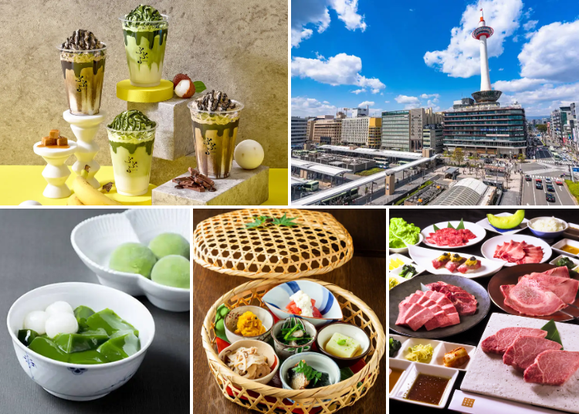
15 Must-Try Restaurants Near Kyoto Station: From Yakiniku to Ramen, Kaiseki, Matcha, and More
by: Tiffany YU
Inspiration for Accommodations

Charming Hotels to Enjoy the Spectacular Views of Arashiyama's Autumn Leaves from Your Room

Enjoy Family Fun in Namba! 10 Hotels with Comfortable Family Rooms

Recommended by Visitors! Arashiyama's Best-Rated Hotels

Luxury of Viewing Osaka Castle from Your Room! Recommended Hotels Near Osaka Castle

Enjoy Night Views from Your Room! Recommended Hotels in Namba Area

Enjoy a Comfortable Stay in Osaka! 10 Hotels with Convenient Airport Shuttle Services

Top 10 Recommended Hotels Near Namba Station with Great Access

Hoshinoya Kyoto: This Incredible Japanese Hotel Welcomes You By Boat on a Sakura-Filled River

Kiku-Masamune Sake Brewery Museum: See How Some of Japan's Best Sake is Made

Complete Guide to Buying Japanese Medicine in Japan: Phrases and Vocabulary You Need to Know

Popular Food at Universal Studios Japan

What to Pack for Japan: 8 Essential Things for a Hassle-Free Trip

What the Heck is Kanji Anyway?! Uncovering the Mystery of Japan’s Alphabet at Kyoto’s “Kanji Museum”
- #best gourmet Osaka
- #things to do Osaka
- #what to do in kyoto
- #what to bring to japan
- #best gourmet Kyoto
- #new years in Osaka
- #what to buy in nanba
- #Visiting Osaka
- #onsen tattoo friendly arima
- #Visiting Kyoto
- #best japanese soft drinks
- #japanese fashion culture
- #japanese convenience store snacks
- #japanese nail trends
- Find & Reserve
- Special Offers
- Meetings & Events
- Our Credit Cards
- About Marriott Bonvoy
- Careers at Marriott
Reservations are not yet available for Four Points Express by Sheraton Kyoto Oike

Four Points Express by Sheraton Kyoto Oike
- Experiences

Welcome to Four Points Express by Sheraton Kyoto Oike
Rooms & suites.
Rates vary by date & room type
FEATURED AMENITIES ON-SITE
Hotel information.
Check In: 3:00 pm
Check Out: 11:00 am
Pets Not Allowed
Getting Here
661 Ogiyacho, Oshikoji-sagaru, Sakaimachi-dori, Nakagyo-ku, Kyoto, Kyoto, Japan, 604-0824
Property Details
Property has elevators
For more information about the physical features of our accessible rooms, common areas or special services relating to a specific disability please call +81 75-256-8221
Mobility accessible rooms
Frequently Asked Questions
The check-in time at Four Points Express by Sheraton Kyoto Oike is 3:00 pm and the check-out time is 11:00 am.
The pet policy at Four Points Express by Sheraton Kyoto Oike is:
The parking options at Four Points Express by Sheraton Kyoto Oike are:
Parking Not Available
The property amenities at Four Points Express by Sheraton Kyoto Oike are:
Yes, Four Points Express by Sheraton Kyoto Oike has free Wi-Fi available to hotel guests.
Unlock your stay with the Marriott Bonvoy™ App
FOUR POINTS EXPRESS BY SHERATON™ KYOTO OIKE
661 Ogiyacho, Oshikoji-sagaru, Sakaimachi-dori, Nakagyo-ku,
Kyoto, Kyoto, Japan, 604-0824
Fax: +81 75-256-8225
Top Destinations
Our company.
© 1996 – 2024 Marriott International, Inc. All rights reserved. Marriott Proprietary Information
Please select your preferred language
The americas, asia and oceania.
- Bahasa Indonesia
INTERNATIONAL

IMAGES
COMMENTS
Rome2Rio makes travelling from Kyoto to Osaka easy. Rome2Rio is a door-to-door travel information and booking engine, helping you get to and from any location in the world. Find all the transport options for your trip from Kyoto to Osaka right here.
The fastest way to travel between Osaka and Kyoto is the shinkansen (bullet train). This costs Y1420 and takes 14 minutes. In Osaka, the shinkansen operate from Shin-Osaka Station. In Kyoto, they operate from Kyoto Station. This is a great option for Japan Rail Pass holders. Note, however, that you cannot ride the Nozomi shinkansen with a Japan ...
Via bullet train: Tokaido Shinkansen Line (12min) The fastest way to travel from Kyoto to Osaka is via the Tokaido Shinkansen line — Japan's busiest Shinkansen line which connects Tokyo, Kyoto, and Osaka. This high-speed Shinkansen from Kyoto to Osaka is managed by JR Central and takes just 12 minutes from Kyoto station to Shin-Osaka station.
The JR Kyoto Line for Osaka Station. Osaka Station is best served by the Special Rapid service on the JR Kyoto Line. The Special Rapid Train will get you to Osaka Station in 28 minutes for 560 yen. Trains depart from platforms 4 and 5 at Kyoto Station. The Keihan Limited Express for Yodoyabashi Station.
Run by the Hankyu train company, it takes the same route as the above services and can get you to Osaka in less than 50 minutes. This train operates on Saturdays and Sundays and leaves Kyoto at 10.41, 12.41, 14.41, 16.41. Surprisingly, the Kyo Train Garaku costs the same as the normal Hankyu Railway trains.
By Hankyu Railway. Direct. 40 min. ¥ 410. frequent departures. Limited express trains on the Hankyu Kyoto Line get you from Osaka-Umeda Station (next to JR Osaka Station) to Karasuma and Kyoto-Kawaramachi stations in central Kyoto in roughly 40 minutes and for 410 yen. They are not covered by the Japan Rail Pass.
The two cities are approximately 55-60 kilometers away, and it takes about an hour to cover that distance in a car. A taxi from Kyoto to Osaka will cost you some $200, which really isn't worth the money. Not only is it some 10 times more expensive than the fastest train, but it also takes 3-4 times longer.
Japan Railways Shinkansen operates a train from Kyōto to Shin-Ōsaka Station every 15 minutes. Tickets cost $16-27 and the journey takes 12 min. Three other operators also service this route. Alternatively, ALPICO Kotsu operates a bus from Kyoto Station to Osaka-Umeda (Hankyu) once daily, and the journey takes 1h 18m. Train operators.
Kyoto is one of Japan's most popular tourist destinations, with its rich cultural heritage, beautiful scenery and convenient transportation. Whether you want to explore the ancient temples and shrines, enjoy the seasonal festivals and events, or experience the local cuisine and shopping, you can find useful information on how to get to and around Kyoto from Osaka and other major cities on this ...
Rome2Rio makes travelling from Kyoto to Osaka Umeda easy. Rome2Rio is a door-to-door travel information and booking engine, helping you get to and from any location in the world. Find all the transport options for your trip from Kyoto to Osaka Umeda right here.
There's another delightful alternative. Hop aboard the Special Rapid Service on the JR Kyoto Line for a charming 30-minute journey. This line, operated by Japan Railways (JR), offers rapid transit with limited stops, making it an fast option for commuters and travellers who want a quick journey between Kyoto and Osaka.
Bullet Train (Shinkansen): The Fastest Method. The Shinkansen (bullet train) is the fastest way to travel between Osaka and Kyoto. You can reach JR Kyoto Station from JR Shin-Osaka Station, a single stop away on the Shinkansen, in just 15 minutes. However, the difference in travel time when compared to taking a train is about 15 to 30 minutes.
The Shinkansen bullet train using the Tokaido Sanyo Line makes the journey quick and simple, getting from Kyoto to Osaka in just a bit under 15 minutes. Both the Thunderbird Limited Express Train and the Haruka will depart from Kyoto Station. The Haruka Limited Express Train will go all the way out to Kansai International Airport, with a stop ...
Kansai International Airport to Kyoto. The journey from Kansai International Airport (KIX) to Kyoto takes longer than from central Osaka. The fastest option is the Haruka Express (limited express) which takes 70 minutes to get to Kyoto Station. It's covered by the JR Pass but costs 1,880 yen if you don't have one.. Haruka Express. There's also a slower, cheaper option (covered by the JR ...
The most expensive variant is to opt for a Train - a one-way Train ticket can cost as much as USD 48. Here is a chart of the average ticket prices and transportation options available from Kyoto to Osaka: Bus tickets - USD 7 to USD 7; Train tickets - USD 20 to USD 48; You can order a taxi, too - an estimated cost of the ride is from USD 206 to ...
It gets you to the heart of Kyoto. The train goes from Osaka-Umeda Station to Kyoto-Karawamachi Station located right in central Kyoto by Gion, Pontocho, and Nishiki Market in approximately 48 minutes. You can also make an easy change to get to Arashiyama. And it only costs ¥410 (US$2.90, £2.26, AU$4.37).
If you are to travel from Kyoto to Osaka, the Nozomi bullet train is your perfect option. Fast travel time and amazing onboard amenities are to provide you with an outstanding travel experience. All Kyoto to Osaka Shinkansen bullet trains are designed to offer the passengers everything they might need during the journey, including several ...
Rome2Rio makes travelling from Osaka to Kyōto (Station) easy. Rome2Rio is a door-to-door travel information and booking engine, helping you get to and from any location in the world. Find all the transport options for your trip from Osaka to Kyōto (Station) right here.
Additional Kyoto and Osaka Itinerary Tips. There are multiple ways to travel between Kyoto and Osaka. The shinkansen (Y1420) is the fastest option, taking approximately 15 minutes. Other options include the JR Train (Y560, 30 minutes) and a bus that travels between Kyoto Station and Osaka's Universal City Station (Y900).
1 Why You Shouldn't Take the Bullet Train from Kyoto to Osaka. 2 The Best Ways to Go Between Osaka and Kyoto. 2.1 Keihan Line. 2.2 JR Special Rapid Service. 2.3 Hankyu Line. 2.4 Shinkansen + Midosuji Line. 2.5 "Back ways" to Osaka. 3 How to Travel from Kyoto to Osaka's Airports. 4 Other FAQ About Travel from Kyoto to Osaka.
Japan Travel app supports international tourist traveling to Japan with the most efficient navigation. You can find destinations to visit, plan itineraries, make reservations, and search routes while actually traveling. ... Shin-osaka To Kyoto Timetable. ... Customize Options. Sort By. Preferred Route. Means of Transportation. Airplane ...
Re: Travel option from Kyoto to Osaka and Nara. Aug 1, 2024, 11:39 PM. For just a Kyoto - Osaka - Nara run, don't bother with any passes. The usual transport methods are via JR or Kintetsu. JR is the one to use if you are staying at Osaka/Umeda or Tennoji. Choose Kintetsu if you are staying at the Namba area.
Kyo Yaki (Kyoto ware) is an umbrella term for pottery produced in Kyoto, dating back to the late 5th century. It encompasses a wide variety of styles and techniques, known for its elegant forms and originality. Kiyomizu Yaki is a subcategory of Kyo Yaki, specifically referring to ceramics produced in the vicinity of Kiyomizu Temple. These ceramics range from everyday items like plates and ...
Yasaka Pagoda and Sannen Zaka Street in Kyoto, Japan. getty. Japan is a country that seamlessly blends the old with the new, offering travelers a unique opportunity to experience its rich history ...
Rome2Rio makes travelling from Osaka Port to Kyoto easy. Rome2Rio is a door-to-door travel information and booking engine, helping you get to and from any location in the world. Find all the transport options for your trip from Osaka Port to Kyoto right here.
The Nintendo Museum is a special place where you can explore and experience the wide variety of products Nintendo has created over the years. Located in Uji City, Kyoto Prefecture, it was built by renovating the old Nintendo Uji Ogura Plant. Since Nintendo announced this project in 2021, fans around the world have been eagerly waiting for its opening. Now, the wait is almost over—the museum ...
661 Ogiyacho, Oshikoji-sagaru, Sakaimachi-dori, Nakagyo-ku, Kyoto, Kyoto, Japan, 604-0824 Tel: +81 75-256-8221 Osaka International Airport - Itami